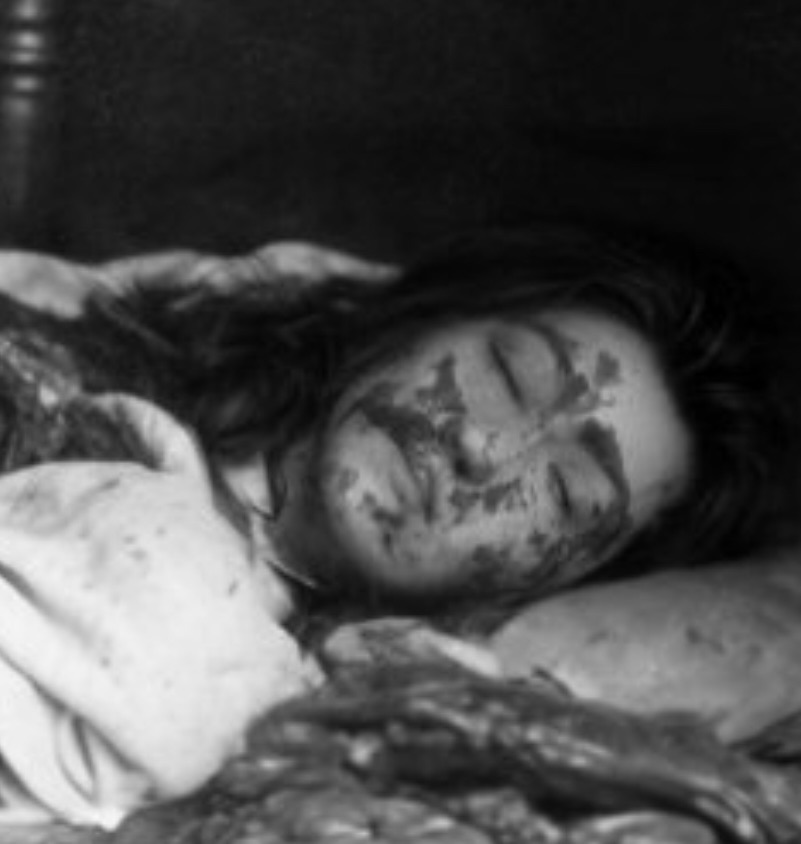
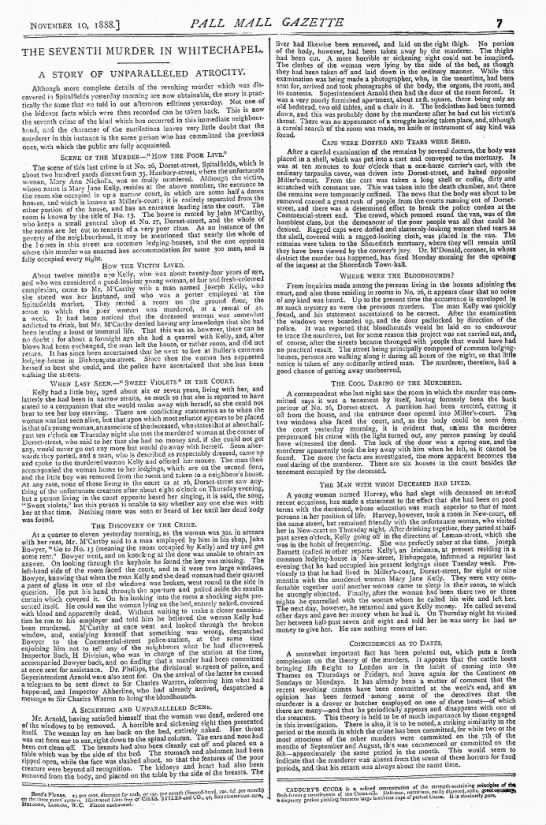
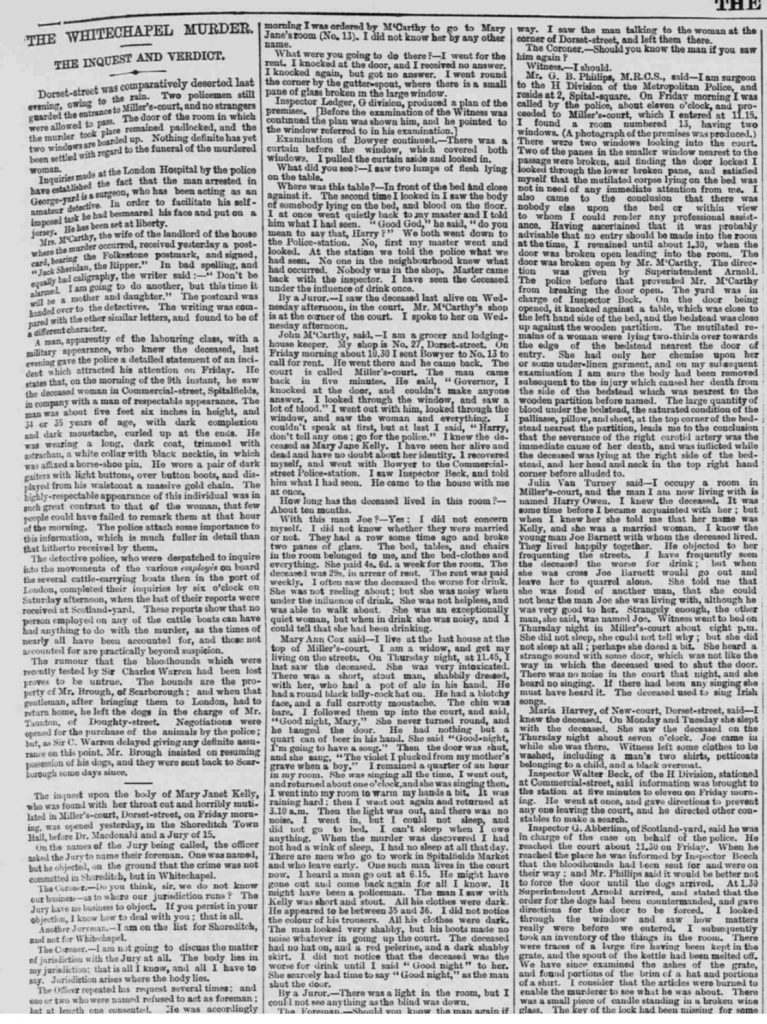
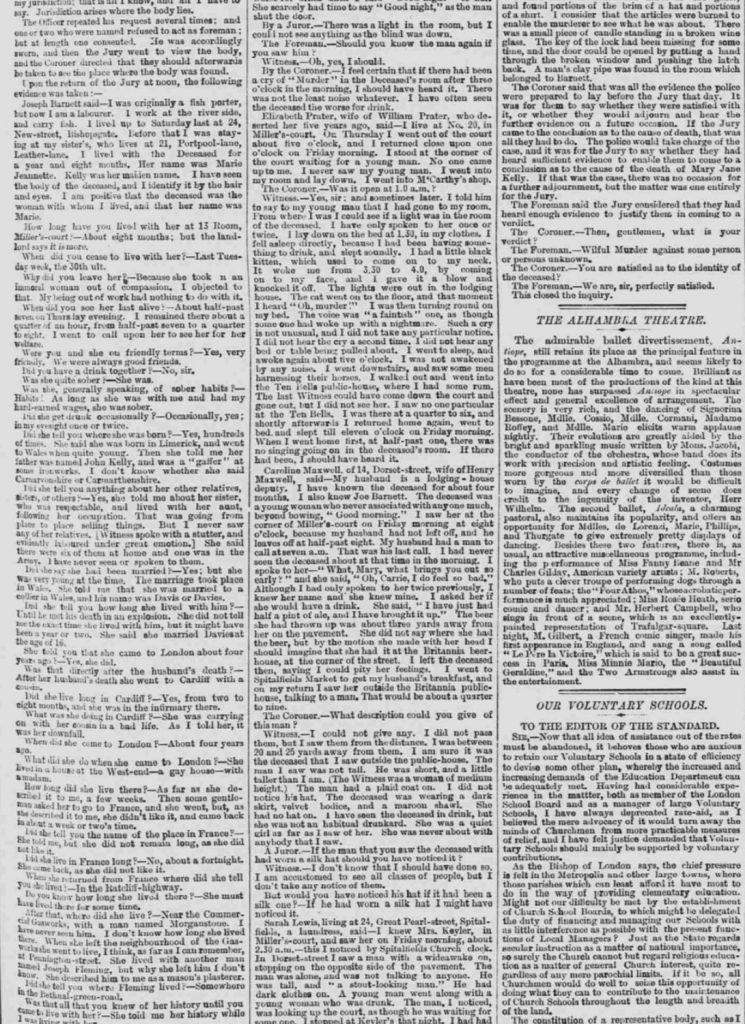
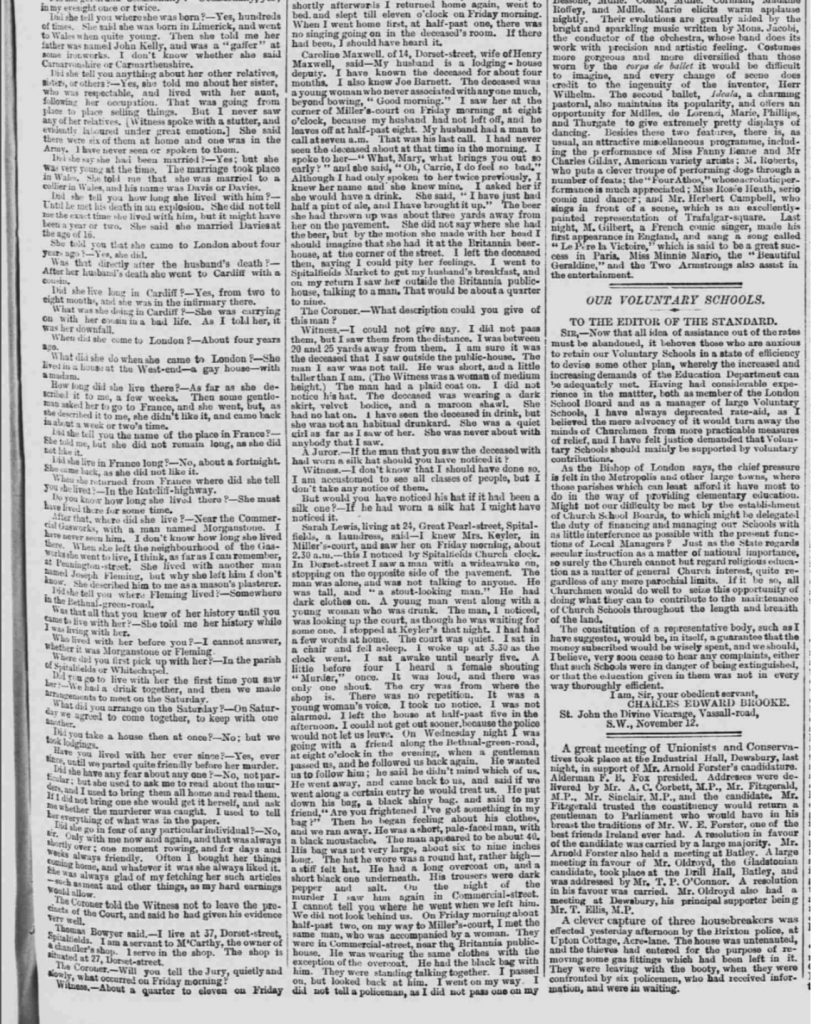
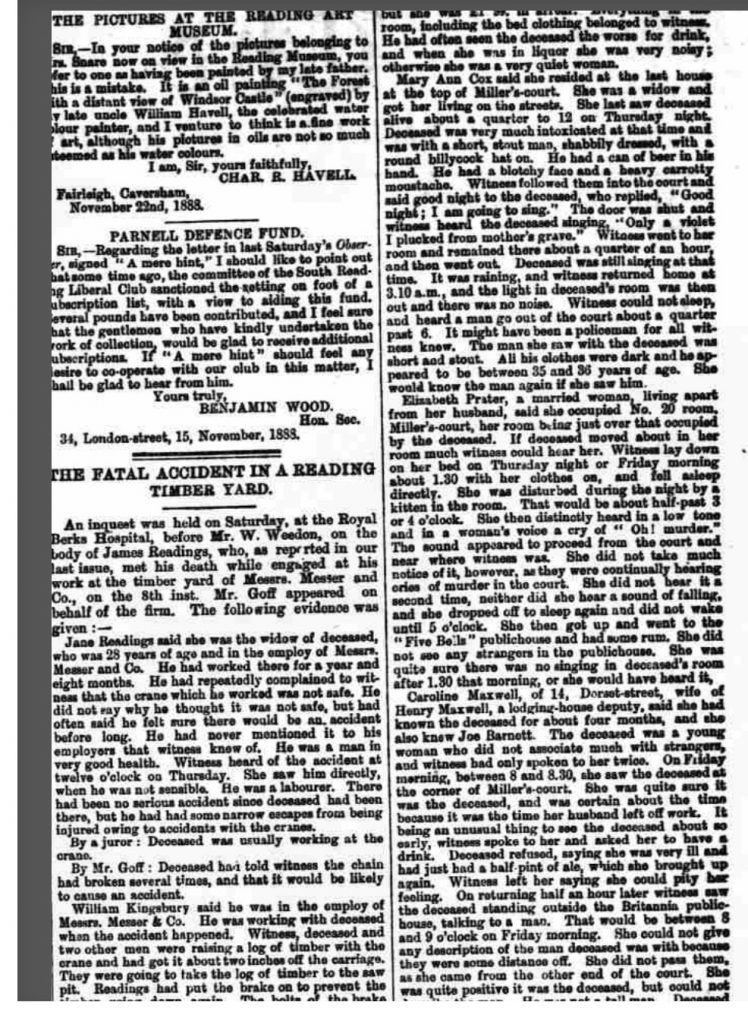
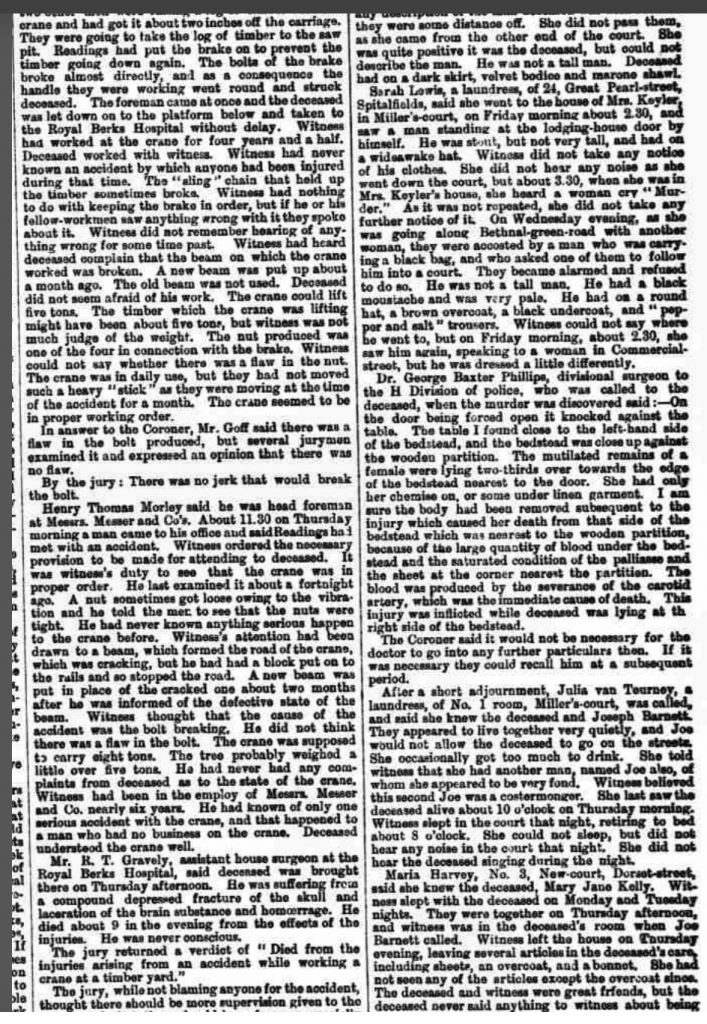
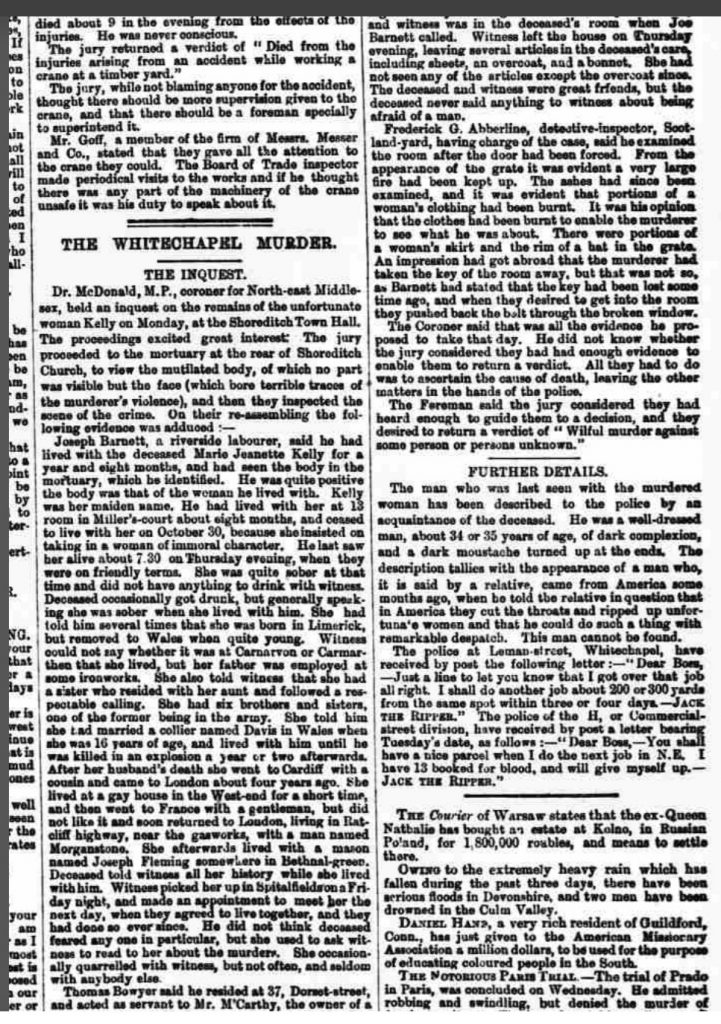
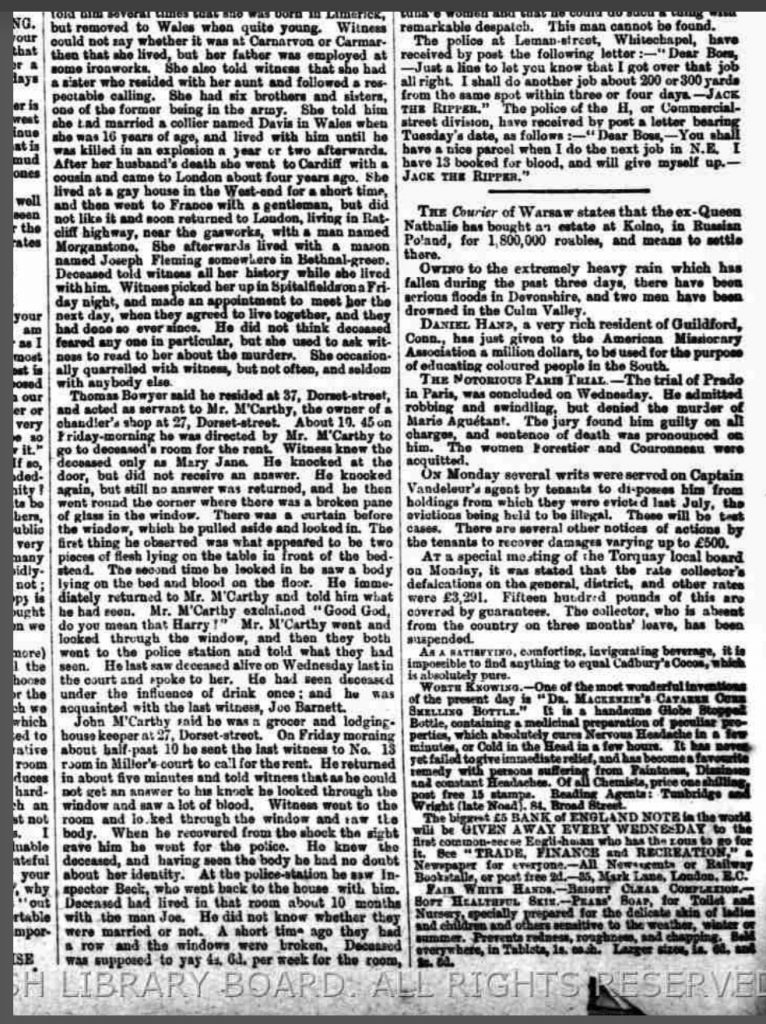

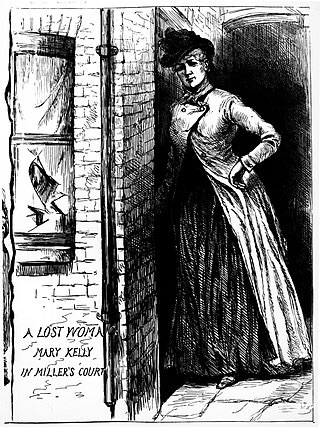
Tidigt i livet
Mary Jane Kelly är det offret som man vet minst om. Om det var hennes verkliga namn är inte heller bekräftat. Det mesta om hennes liv kommer från hennes sista man Joseph Barnett. Det finns dock en del tankar som inte helt har bekräftas. Hon tros komma från staden Limerick på Irland. Med lite sökningar i registret från den katolska kyrkan Castleconnell register finns det dock en flicka som är född 31 mars 1863. Föräldrarna är Michael och Ellen Kelly. Joseph Barnett hävdar dock att hennes fars namn var John Kelly.
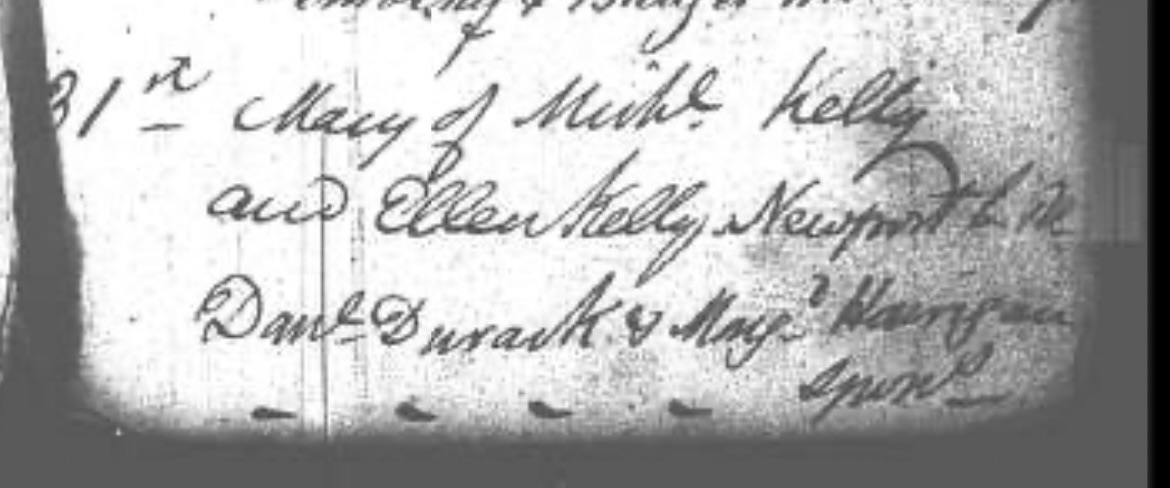
Det sägs att hon kommer från en stor och inte helt fattig familj samt att hon ska ha en syster, Bridget. I kyrkoboken finns det en sådan registrerad 1860, 7e november.
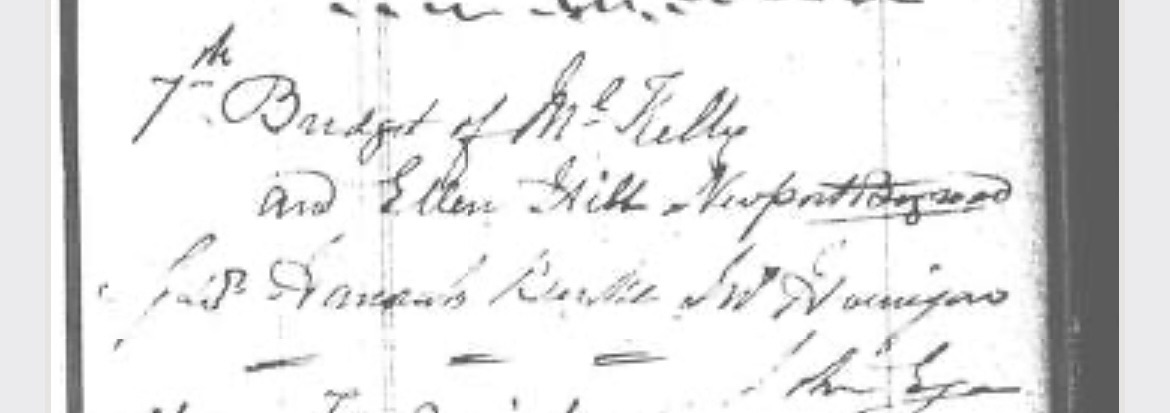
Det finns även ett namn till, dock har jag lite svårare att tyda detta.
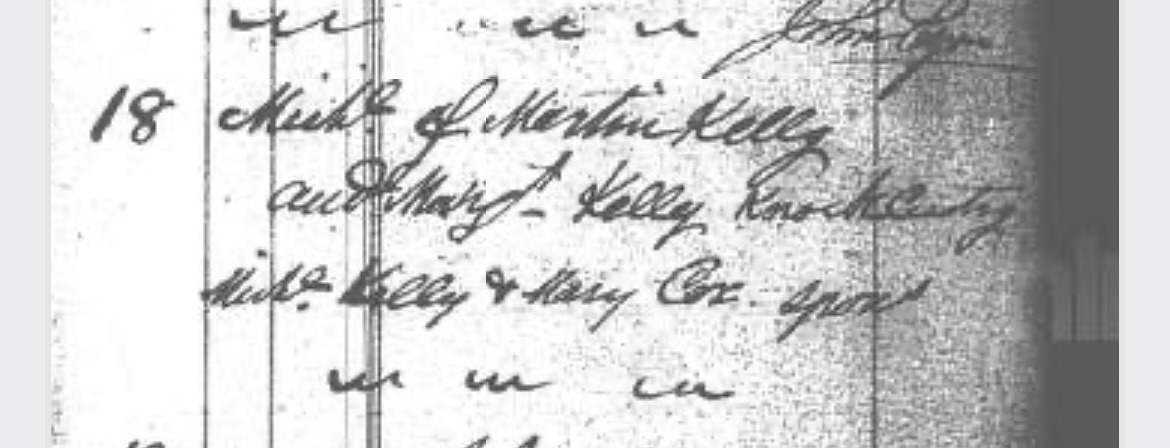
Vad jag kan hitta, finns det en Michael Kelly boende någon gång runt 1850-60, på Black Bull Lane 8 (källaren)
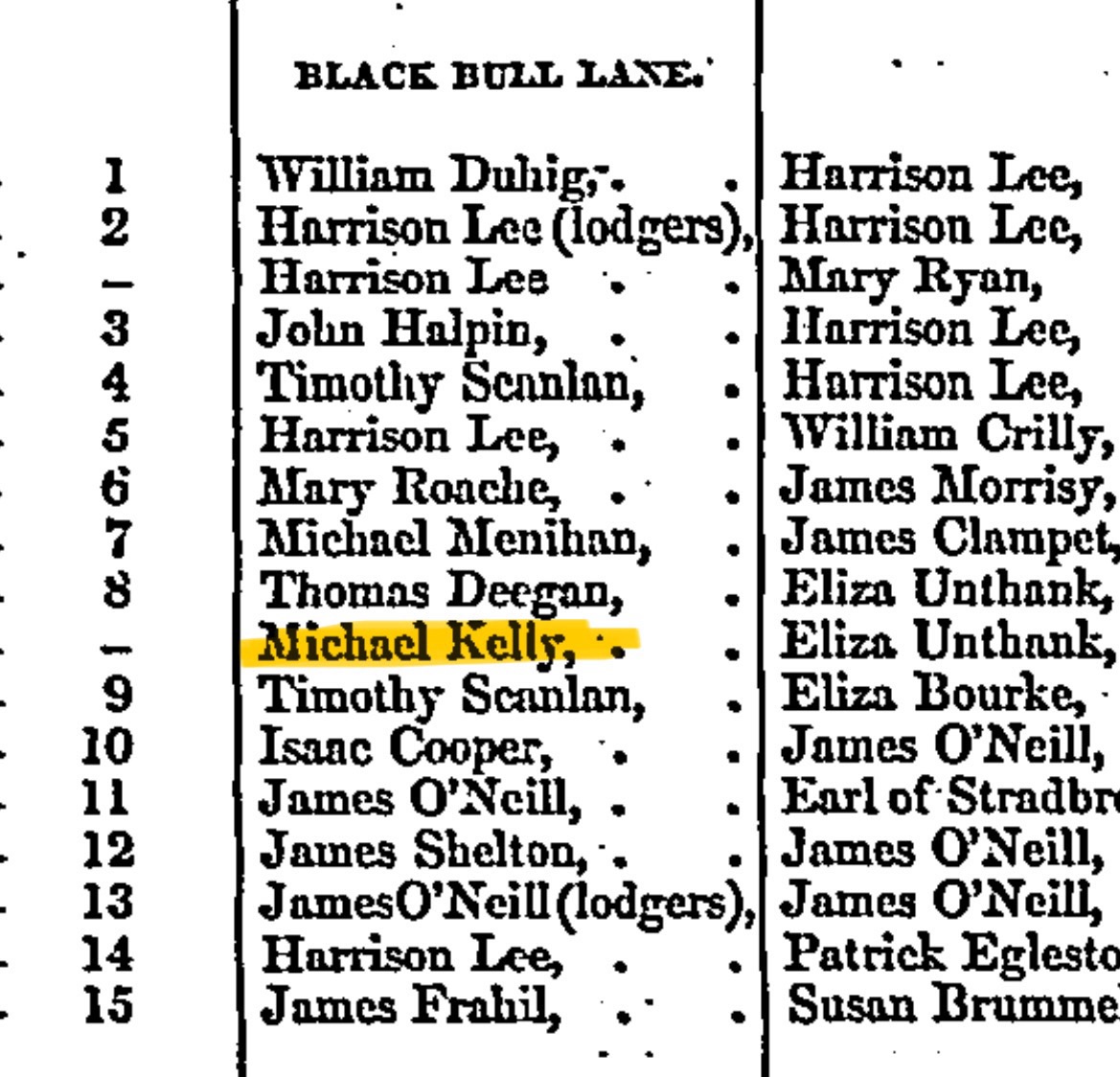
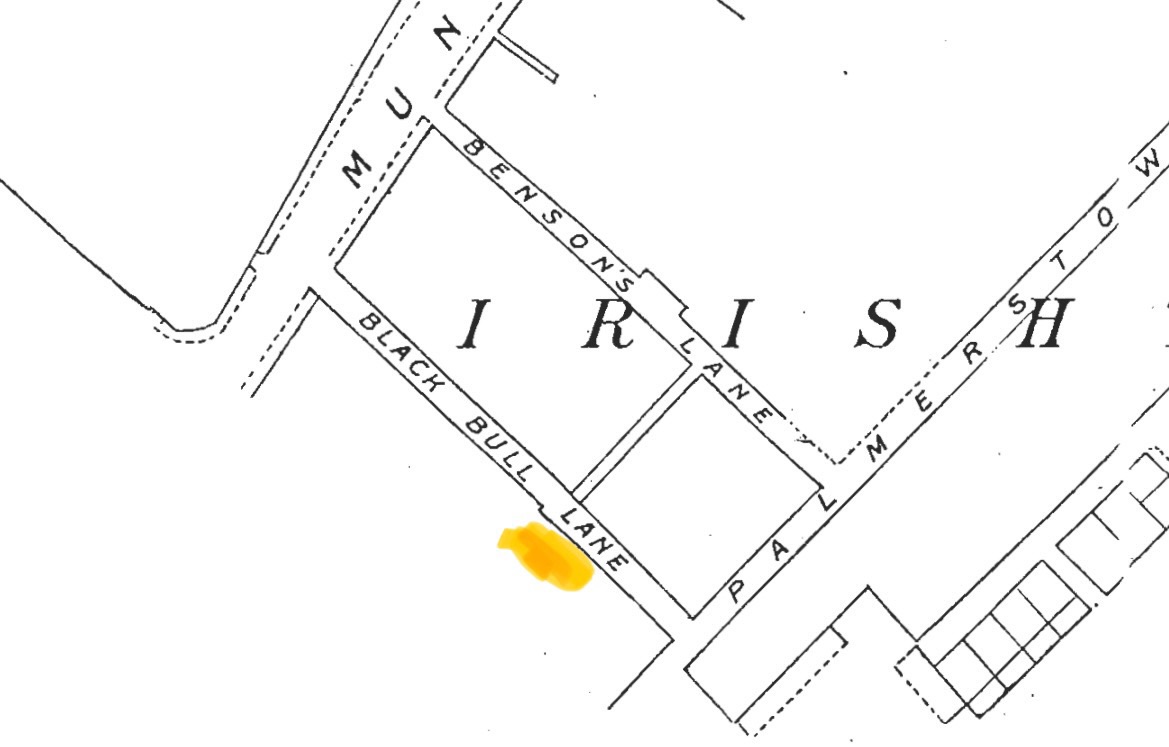
Det skulle kunna härifrån Mary kommer. Dock blev uppväxten kortvarig och hela familjen flyttar , tros vara mellan 5-8 syskon. Familjen flyttar till Wales för att jobba i gruvorna. Mest troligt är att familjen hamnar i staden Caranvonshire eller Carmanthenshire. När Mary är ung (1879) ska hon ha gift sig med Davis eller Davies. Någon hävdar att hans namn var James Davies, gruvarbetare, som dog i Risca 1880 och att dem var förlovade. Davis ska dock ha omkommit i en sprängolycka efter några år. Mary beger sig då till Cardiff och hamnar på sjukhuset i flera månader. Vad hon gjorde där finns inga bevis för.
Varför hon ger sig av vet man inte. En teori är att hon på något sätt hamnar i onåd med sin familj. Joseph Barnett sa i ett av förhören att han identifierade Mary på hennes öra. Mary var känd för att inte ha något huckle på sig (vilket var ovanligt) en teori att hon gjort sig illa i örat (höger) och att det blev deformerat på något sätt. Till följd av detta valde Mary att ha håret utsläppet och dölja sitt öra och kanske var det därför hon var inlagd dessa månader på sjukhus.
Hon flyttade in med sin kusin i Cardiff och det var här hennes bana som prostituerad börjar.
1883 döms hon till fängelse i 6 månader för förfalskning i Cardiff. Hon döms även för en stöld på en bordell i NewPort 1881 (troligen stöld från en kund).
Livet i London
Det finns inget bekräftat foto av Mary Jane (förutom dem från mordplatsen). Men här är ett foto som hävdar vara en bild på henne.
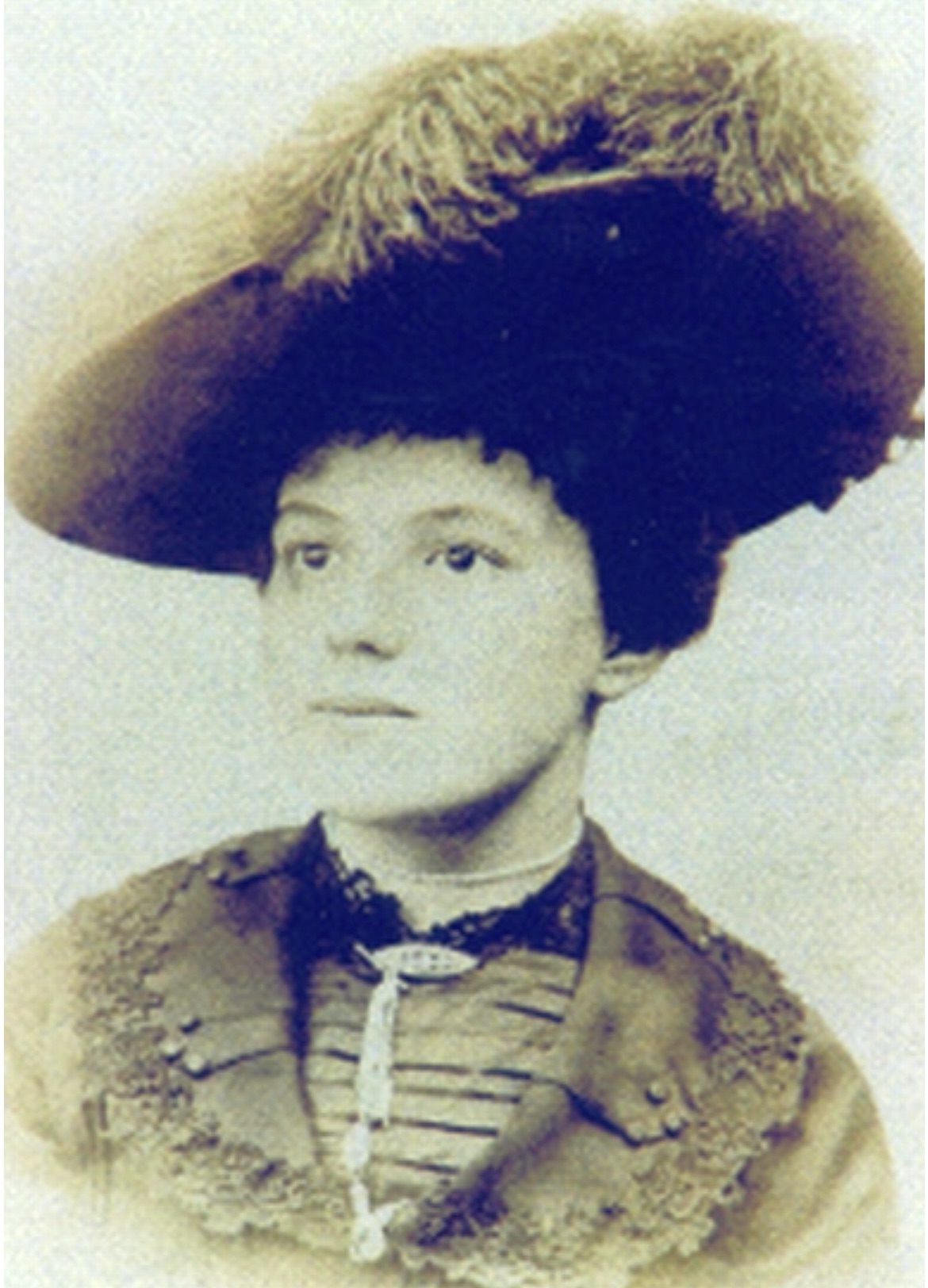
Hur likt det är med skissen från tidningen efter mordet, eller att hon kallades för Ginger (på grund av hennes hår), är lite oklart.
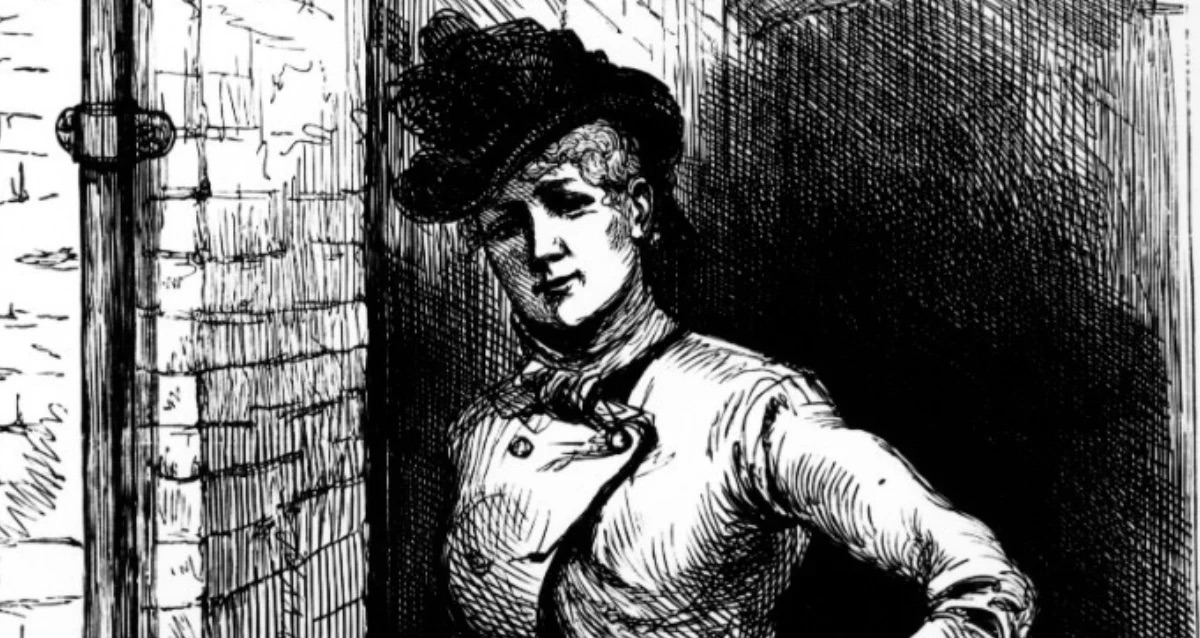
En bild som sägs vara hennes syster Bridget har även visats men även här, oklart.
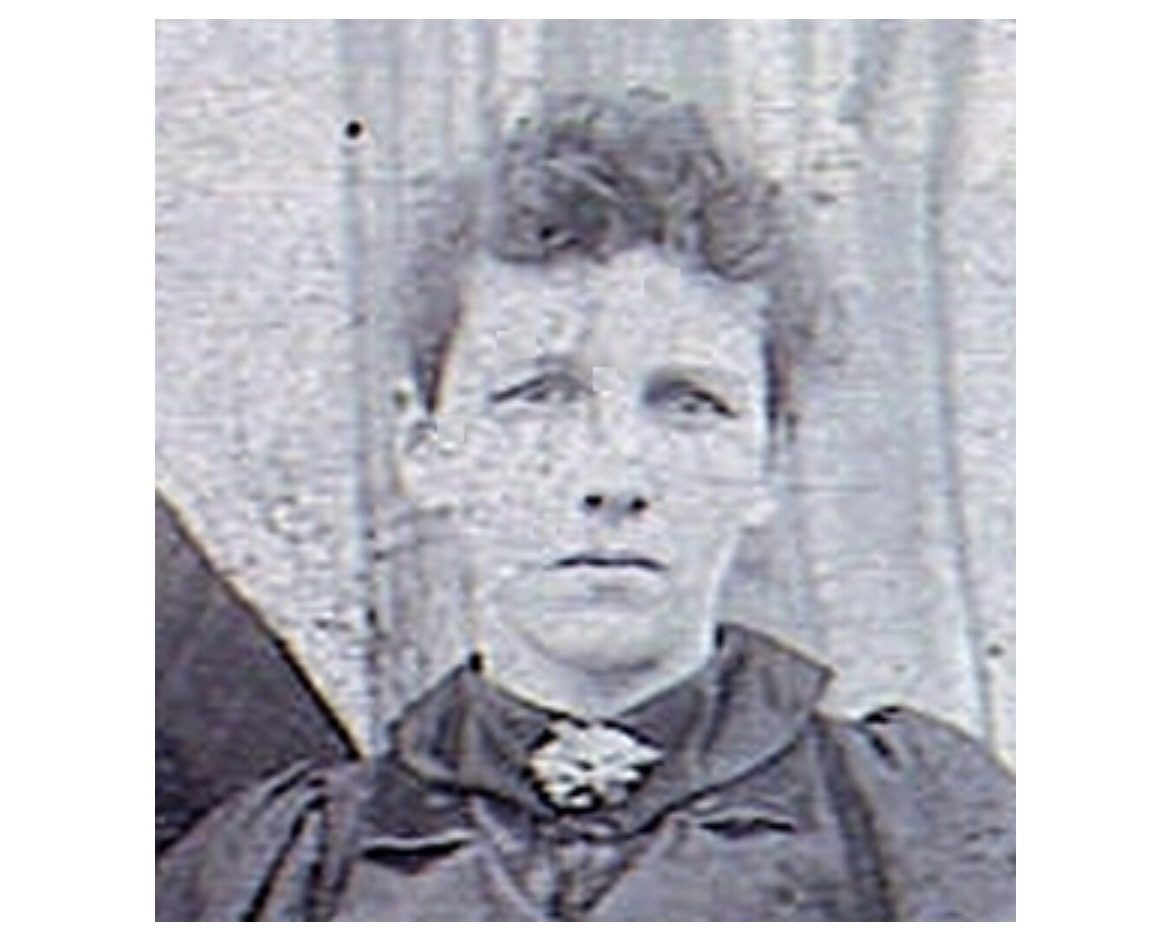
Vilket år hon kommer till London är inte helt fastställt, troligen var det 1884. Väl i London jobbade hon på en bordell i Kensington som troligen drevs av ”the Maundrell sisters”. Héleine and Frederica Maundrell drev en ”överklass bordell”. Hon lämnade detta hastigt och troligen på grund av stöld. Hon flyttade in i ett rum på St George Street men fick lämna på grund av alkohol och droger. Kelly flyttade in hos Mrs Carty, en dam som delvis verifierar Barnetts historia om Mary. Dock var detta en plats man inte stannade så länge på, på grund av, att det var ” a bad place”. 1886 flyttade hon till Cooley’s Lodging House på Thrawl Street.
En annan teori är att Mary Jane var vän och modell till konstnären Walter Sickert. Hon tillbringande en tid i Frankrike som prostituerad. Efter att ha granskat Sickerts målningar och teckningar skulle denna bild kunna vara Mary Jane (baserat på den obekräftade bilden). Men att Sickert skulle vara Jack the ripper är ingen teori jag tror på.
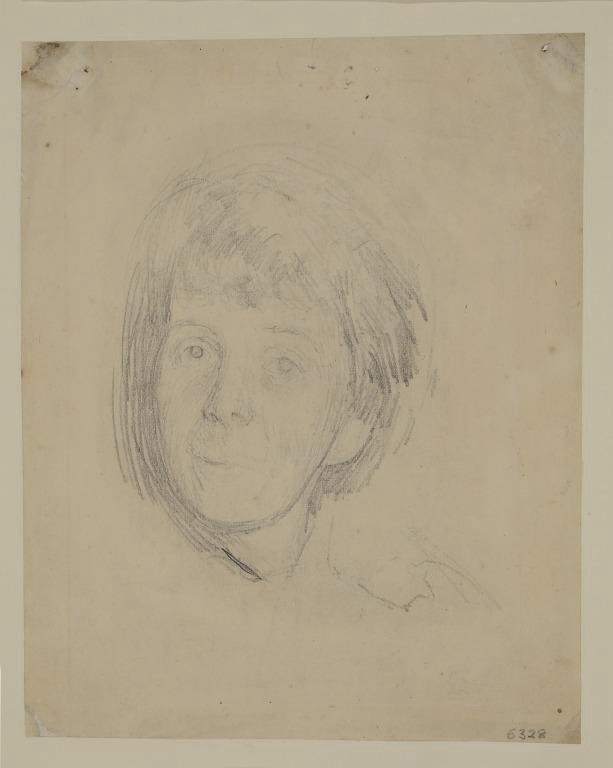
I april 1887 träffar Mary Joseph, som också var Irländare. Den flyttar ihop nästan omgående. Mary flyttade till Whitechapel och Dorset street någongång 1887 med Joseph Barnett.
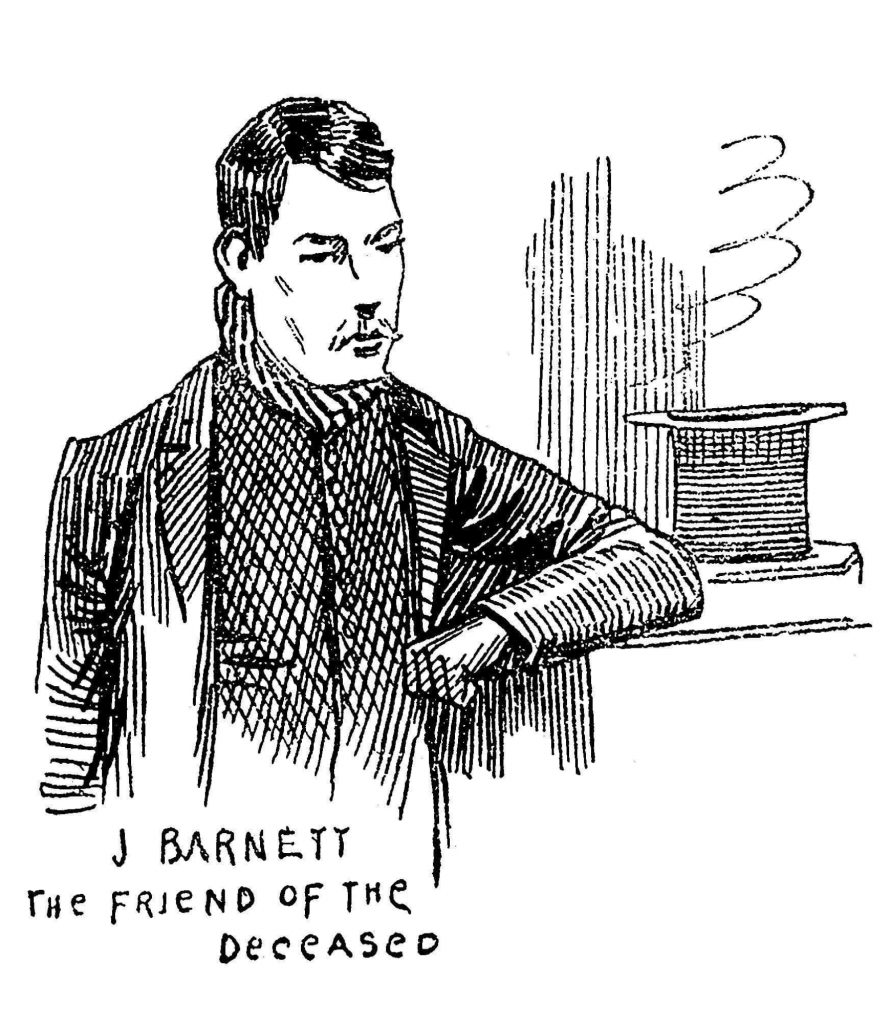
Mordet
Mary Jane Kelly var troligen 25 år när hon mördades. Hon var 170 cm lång och muskellös. Hade blont/rött hår. Blåa ögon och var ljus i hyn.
”Said to have been possessed of considerable personal attractions.”
När hon sist sågs hade hon en ”linsey frock” (klänning) och en röd sjal runt sina axlar. Hon bar inget på huvudet.
Konstapel Walter Dew sa att han väl kände igen henne, hon var vacker och spatserade runt med sina vänner. Mary var känd för att alltid ha ett vitt rent förkläde på sig.
Maria Harvey, en vän, sa att hon var ”much superior to that of most persons in her position in life.”
Det har också hävdats att hon pratade flytande Welsiska och var konstnärligt lagd. Dem flesta uttrycker sig att hon inte var ett fyllo men att när hon drack kunde bli högljudd. Hon verkar också varit ganska omtyckt av personer i området.
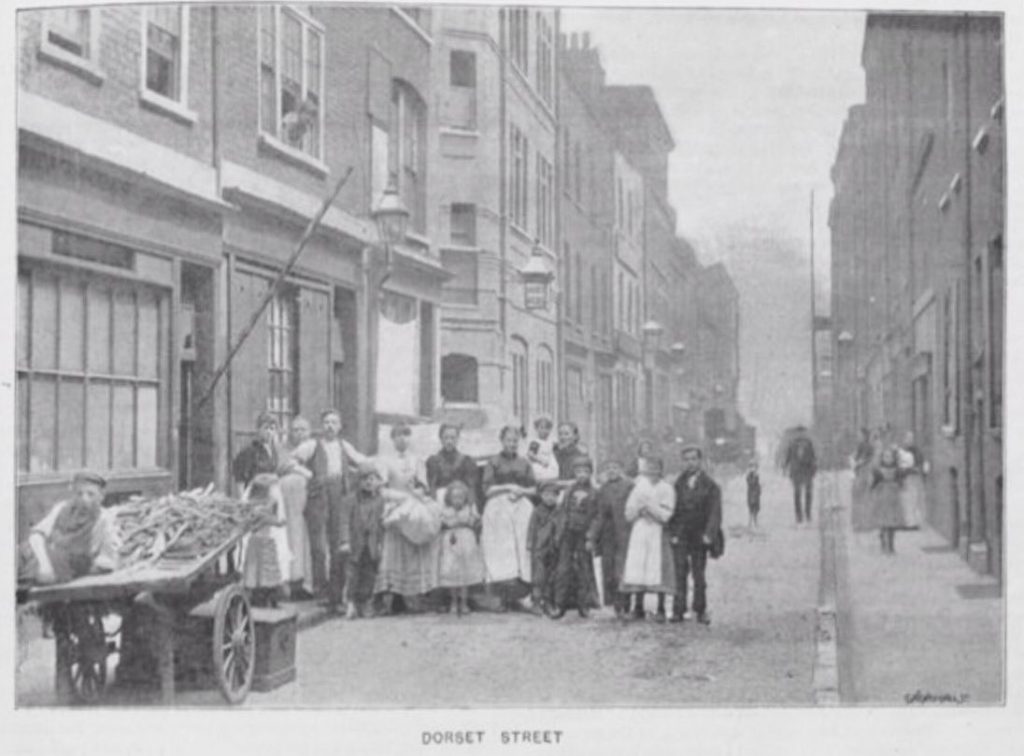
Onsdag 7 November Mary handlar ett ljus från McCarthy’s shop. Hon syns lite senare i Miller’s Court av Thomas Bowyer, en pensionerad soldat som kallades ”Indian Harry.” Han jobbade hos McCarthy och bodde på 37 Dorset Street.
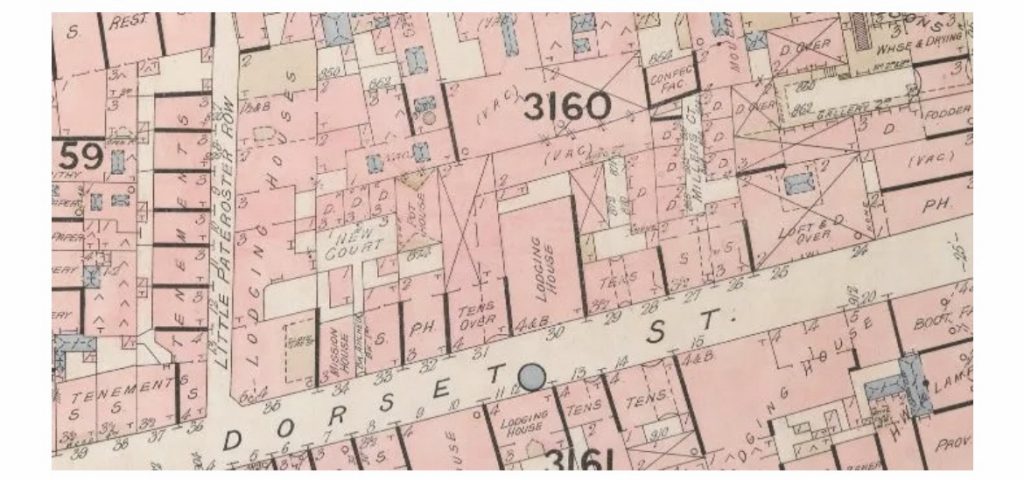
Bowyer säger att han på Onsdags kvällen såg Mary prata med en man (som liknade den man Matthew Packer hävdar han såg prata med Elizabeth Stride).
Torsdag/Fredag 8-9 November Barnett och Mary hade gått skilda vägar men han var och rände hos henne nästan varje dag.
19.15 Fredagen den 9e, Barnett hälsar på hos Mary. Han säger att hon hade besök av en annan kvinna.
Maria Harvey sa att hon var kvinnan Barnett såg med Mary och att hon lämnade henne ca 18.55. Harvey tros ha bott med Mary under perioder. Det har skrivits att Mary hade ett barn när hon bodde här. Det har nu visat sig att barnet som sägs bott på Millers Court är Harvey son John, ca 6år, som tragiskt dog i en olycka där han blev påkörd av en vagn på Whitechapel High Street. Kanske jobbade han med att ta bort hästbajs från gatorna, vilket var ett vanligt (och farligt) jobb för barnen i Whitechapel.
20.00 Barnett lämnar Mary och beger sig till härbärget Buller’s Boarding House. Han spelar kort och går och lägger sig 00.30.
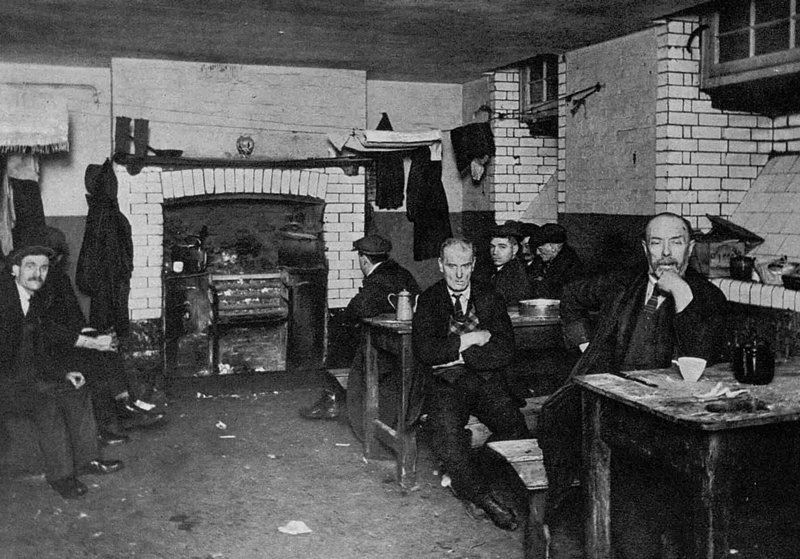
20.00 Julia Venturney, boende på Miller’s Court nr 1 går och lägger sig.
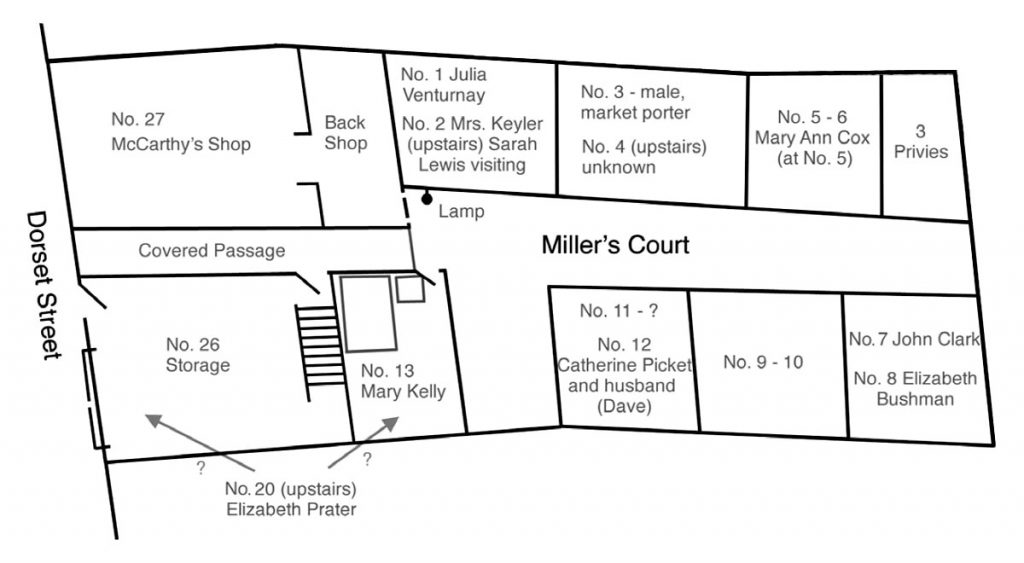
20.00-23.45 Här finns inga bekräftade uppgifter om vad Mary har för sig. Det sägs att hon ses dricka med Elizabeth Foster på the Ten Bells Public House (hörnet Commercial Street/Fournier Street).
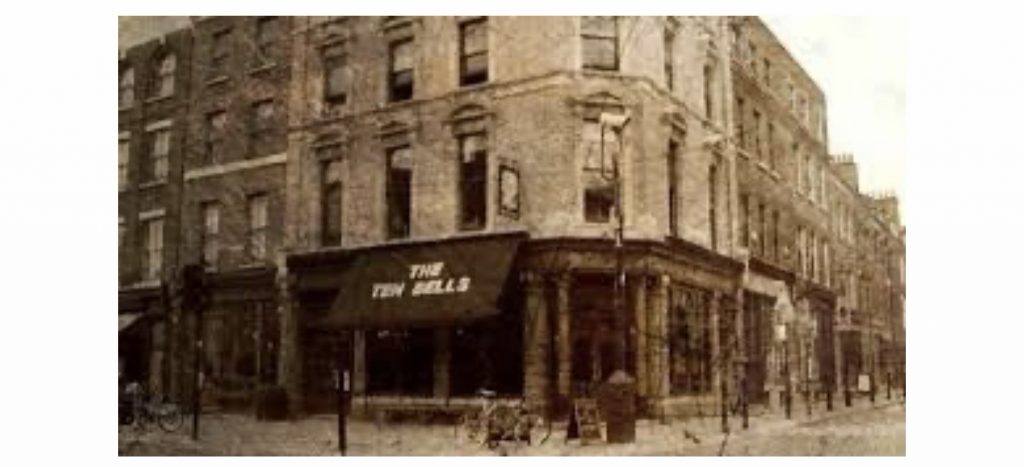
23.00 sägs hon vara på the Britannia (Commercial Street/Dorset Street) och dricker med en man med mörk mustasch som ser respektabel ut. Hon verkar vara väldigt berusad.
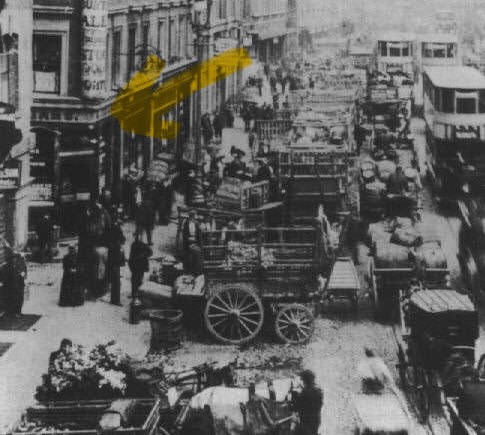
23.45 Mary Ann Cox, 31 år, änka och prostituerad som bodde på nr 5 Miller’s Court. Cox kommer tillbaks hem för att värma sig. Hon ser Mary framför sig på gatan med en kraftig man. Han såg ut att vara i 35-års åldern, ca 165 cm lång, slarvigt klädd med en lång rock och en billycock hatt. Han hade ett fläckigt ansikte med små polisongers och ”carroty mustache”. Mannen bär på en hink med öl.
Cox följer efter dem in på Miller’s Court. Dem står utanför Marys rum. Cox går förbi och säger”Goodnight.” Mary svara lite nonchalant ”Goodnight, I am going to sing.” Några minuter senare hör Cox Mary sjunga ”A Violet from Mother’s Grave”. Cox går ut igen vid midnatt och Mary sjunger fortfarande samma sång.
Här är utdraget från hennes vittnes mål:
Mary Ann Cox stated: I live at No. 5 Room, Miller’s-court. It is the last house on the left-hand side of the court. I am a widow, and get my living on the streets. I have known the deceased for eight or nine months as the occupant of No. 13 Room. She was called Mary Jane. I last saw her alive on Thursday night, at a quarter to twelve, very much intoxicated. [Coroner] Where was this ? – In Dorset-street. She went up the court, a few steps in front of me.
[Coroner] Was anybody with her ? – A short, stout man, shabbily dressed. He had on a longish coat, very shabby, and carried a pot of ale in his hand.
[Coroner] What was the colour of the coat ? – A dark coat.
[Coroner] What hat had he ? – A round hard billycock.
[Coroner] Long or short hair ? – I did not notice. He had a blotchy face, and full carrotty moustache.
[Coroner] The chin was shaven ? – Yes. A lamp faced the door.
[Coroner] Did you see them go into her room ? – Yes; I said ”Good night, Mary,” and she turned round and banged the door.
[Coroner] Had he anything in his hands but the can ? – No.
[Coroner] Did she say anything ? – She said ”Good night, I am going to have a song.” As I went in she sang ”A violet I plucked from my mother’s grave when a boy.” I remained a quarter of an hour in my room and went out. Deceased was still singing at one o’clock when I returned. I remained in the room for a minute to warm my hands as it was raining, and went out again. She was singing still, and I returned to my room at three o’clock. The light was then out and there was no noise.
[Coroner] Did you go to sleep ? – No; I was upset. I did not undress at all. I did not sleep at all. I must have heard what went on in the court. I heard no noise or cry of ”Murder,” but men went out to work in the market.
[Coroner] How many men live in the court who work in Spitalfields Market ? – One. At a quarter- past six I heard a man go down the court. That was too late for the market.
[Coroner] From what house did he go ? – I don’t know.
[Coroner] Did you hear the door bang after him ? – No.
[Coroner] Then he must have walked up the court and back again? – Yes.
[Coroner] It might have been a policeman ? – It might have been.
[Coroner] What would you take the stout man’s age to be ? – Six-and-thirty.
[Coroner] Did you notice the colour of his trousers ? – All his clothes were dark.
[Coroner] Did his boots sound as if the heels were heavy ? – There was no sound as he went up the court.
[Coroner] Then you think that his boots were down at heels ? – He made no noise.
[Coroner] What clothes had Mary Jane on ? – She had no hat; a red pelerine and a shabby skirt.
[Coroner] You say she was drunk ? – I did not notice she was drunk until she said good night. The man closed the door. By the Jury: There was a light in the window, but I saw nothing, as the blinds were down. I should know the man again, if I saw him.
By the Coroner: I feel certain if there had been the cry of ”Murder” in the place I should have heard it; there was not the least noise. I have often seen the woman the worse for drink.
Någon gång under denna tid äter Mary mat som består av fisk och potatis (oklart vart eller när).
00.30 Catherine Pickett, blomstersäljare, och som bor nära Mary (nr.12) stör sig på sången och tänker gå och säga till henne. Hennes man stoppar henne och säger ”You leave the poor woman alone.”.
01.00 Det börjar regna och Cox kommer tillbaks hem igen för att värma sig. Mary sjunger fortfarande. Det lyser från hennes rum. Efter en kort stund beger sig Cox ut igen.
Elizabeth Prater, står utan för ingången till Miller’s Court och väntar på en man. Prater bor i nr 20 på 26 Dorset Street. Detta är rummet ovanför Mary. Hon står ute ca 30 min och väntar men går till slut in till McCarthy’s för att prata. Hon hör ingen sång eller ser någon gå in eller ut från gården. Hon går sedan tillbaks till sitt rum. Hon säger att hon placerar två stolar framför sin dörr och somnar sedan med kläderna på, hon nämner att hon var väldigt full.
02.00 George Hutchinson, boende på ” the Victoria Working Men’s Home” på Commercial Street hade just kommit tillbaks till området. Han går på Commercial Street och passerar en man i hörnet på Thrawl Street men lägger inte märke till något mer. På Flower and Dean Street möter han Mary. Och hon frågar honom om pengar.
”Mr. Hutchinson, can you lend me sixpence?” ”I can’t,” says Hutchinson, ”I spent all my money going down to Romford.” ”Good morning,” Kelly replies, ”I must go and find some money.”
Hon går sedan vidare i riktning mot Thrawl Street. Hon möter mannen som Hutchinson hade gått förbi. Mannen lägger sin hand på Mary och säger något som får Mary att skratta. Hutchinson hör Kelly säga ”All right.” Och mannen svarar ”You will be all right for what I have told you.” Mannen lägger sin hand på hennes axel och dem börjar gå tillsammans mot Dorset Street. I vänster handen har mannen ett litet paket.
När dem står under lampan utanför ”the Queen’s Head Public House” får Hutchinson en bra bild av mannen. Han har ett blekt utseende, tunn mustach där ändarna är vikta uppåt (i tidningsreportern är detta ändrat till en stor tung mustasch). Mörkt hår, mörka ögon och buskiga ögonbryn. Han ser judisk ut. Han har en ”soft felt” hatt nerdragen över ögonen. Han är klädd i en lång rock, med vit krage samt en hästsko på bröstet. Han har en stor guldkedja med en stor röd sten. Han hade handskar i ena handen och ett paket i det andra. Han var runt 35 år och var ca 170-175 cm lång.
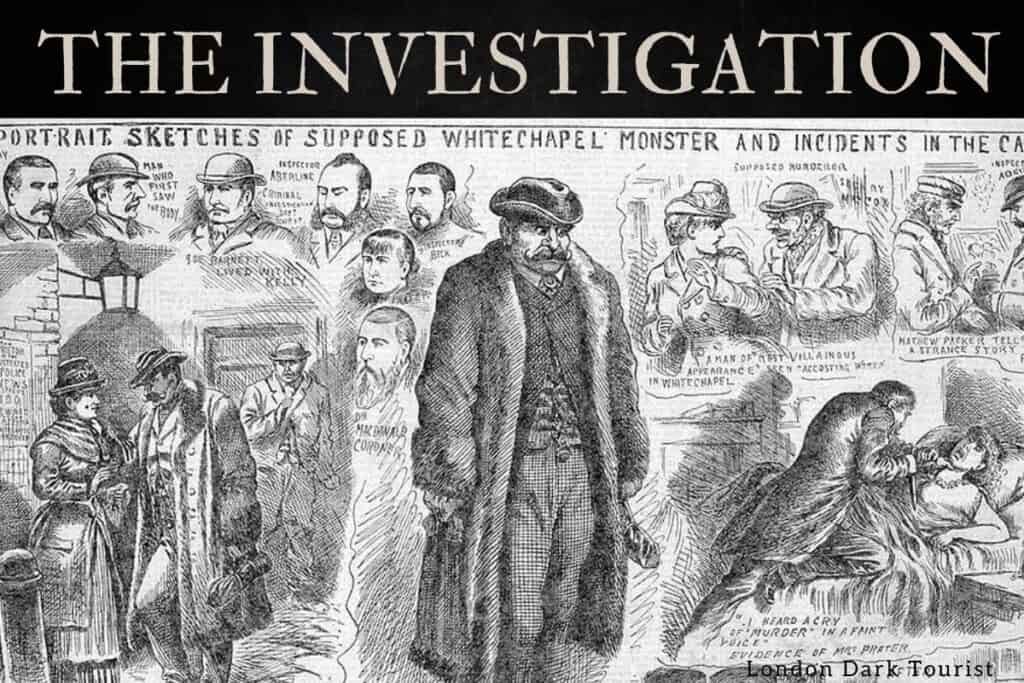
Mary och mannen korsar Commercial Street och går ner för Dorset Street. Hutchinson följde efter. Mary och mannen stannade utanför ingången till Miller’s Court och pratade. Mary säger ”All right, my dear. Come along. You will be comfortable.” Mannen för sin arm runt Mary och hon pussar honom och säger ”I’ve lost my handkerchief.” Hon får då en röd schal av mannen, paret går sedan in på gården. Hutchinson väntar utanför till klockan slår 03.00 och lämnar sedan platsen. Jag tror han tänkte råna mannen men eftersom han inte kom ut och Hutchinson härbärge öppnade klockan 3 så begav han sig av istället.

03.00 Cox kommer hem igen. Det regnar kraftigt ute. Cox säger att det är mörkt och tyst, hon stannar sedan hemma men somnar inte. Hon tycker sig höra män gå in och ut på gården. Hon nämner specifikt att hon hörde någon lämna kl 05.45 men kan inte säga från vilket rum då hon inte hörde någon dörr stängas.
04.00 Elizabeth Prater vaknar av att hennes katt (Diddles) väcker henne. Hon hör någon tyst med gråtande röst ropa ”Oh, murder!” Dessa ord är vanliga i området så hon bryr sig inte så mycket om detta. Sarah Lewis, som sover över hos en vän på gården hör också det tysta gråtandes ropet.
04.00-08.30 finns inga bekräftade händelser.
08.30 Caroline Maxwell, säger sig träffa Mary. Hon beskriver hennes kläder och Mary detaljerat men säger att hon inte känner Mary väl. Hon hävdar bestämt att hon inte har tagit fel på dag utan såg henne vid ingången till gården. Maxwells vittnesmål står i strid med rättsläkaren Philips utlåtande om att Mary troligen dog mellan 02.00-08.30 och att hon åt mat mellan 22.00-23.00.
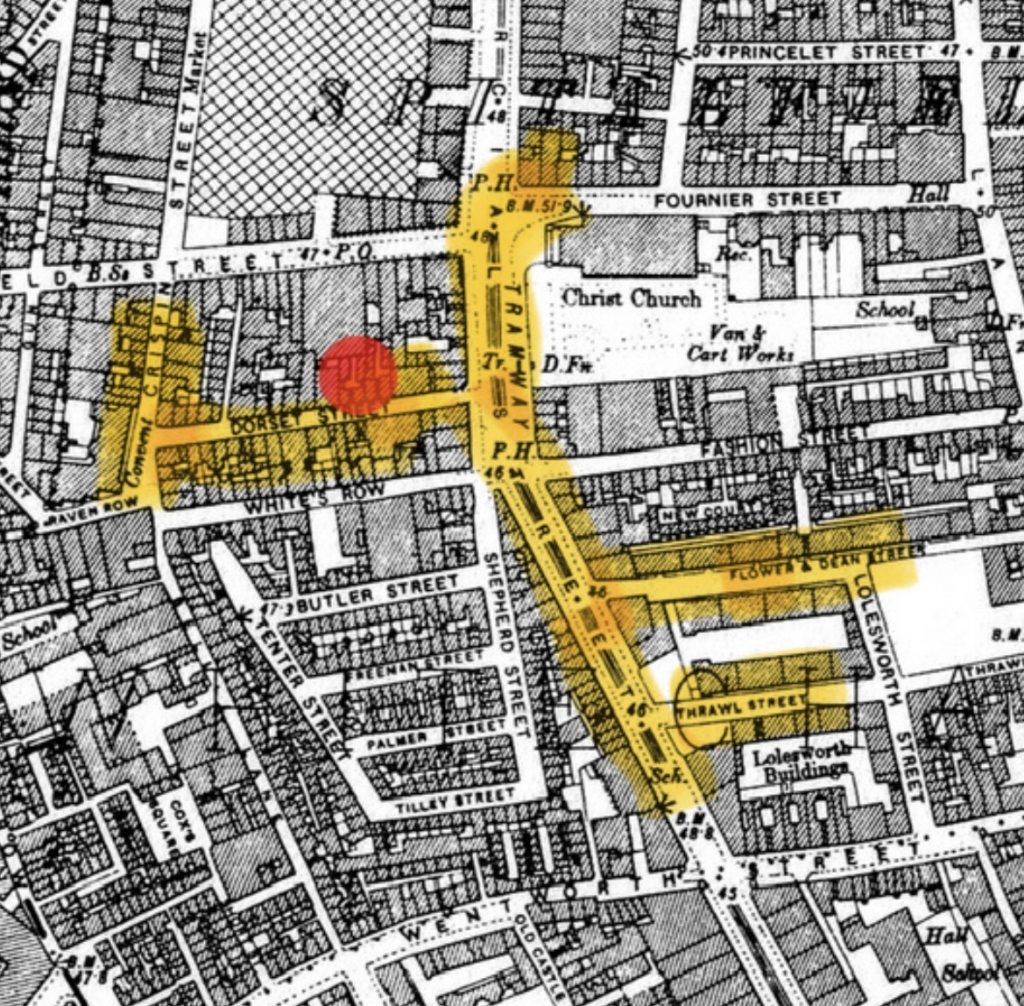
10.00 Maurice Lewis, en skräddare som bor på Dorset Street, säger till tidningen att han såg Mary och Barnett på ”the Horn of Plenty public house” under natten då Mary blev mördad. Det sägs att hon ofta drack på puben (som ligger i slutet på Dorset Street) och även att puben var plats för skumma personer. Han säger också att han såg henne kl 10.00 på morgonen mordet ägde rum. Även han hävdar då att hon synts flera timmar efter den troliga tiden för mordet. Lewis blev dock inte kallad till förhör så hans ord kommer från tidningarna.
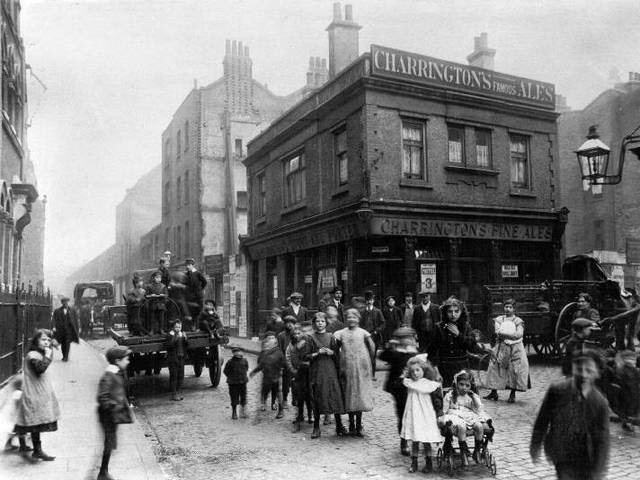
10.45 John McCarthy, ägaren till ”McCarthy’s Rents,” vilket var namnet på Miller’s Court, skickade sin assistent Thomas Bowyer för att hämta pengarna för hyran. Mary låg efter med hyran, som alla andra på denna tid. När Bowyer inte fick något reaktion på dörrknackningen och dörren var låst så han flyttade på gardinen genom det trasiga fönstret och tittade in. Det var då han såg kroppen liggandes på sängen. Han gick då till McCarthy, som även han tittade in genom fönstret och såg den slaktade kroppen. Han sprang då ut på gatan och till Commercial Street Polisstation. Han fick tala med Inspektör Walter Beck, som följde med till gården.

Ingen av poliserna fick gå in i rummet, eller kunde inte, då dörren var låst samt att man väntade på blodhundarna skulle komma och spåra mördaren. Polischefen Charles Warren hade nämligen införskaffat två hundar för att spåra JTR (Barnaby och Burgho) men efter timmar av väntan på hundarna (som för övrigt redan hade lämnat London på grund av ett tjafs med ägaren och myndigheterna om pengar) bestämde Polischefen Thomas Arnold att poliserna skulle bryta sig in med en yxa.
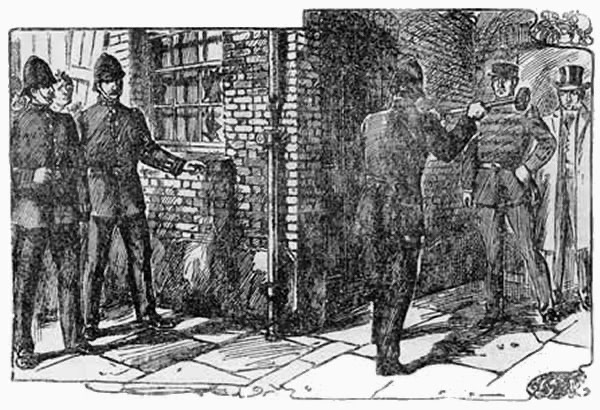
När polisen kommer in i rummet ser dem Marys kläder fint vikta på en stol. Hon var klädd i ett nattlinne. Framför eldstaden stod hennes skor placerade. Det sägs att det var något smält i elden och att elden fortfarande var glödande.
Saker i rummet
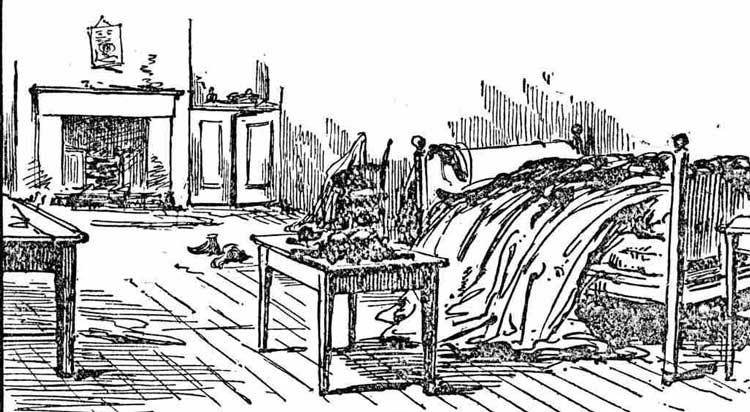
En fotograf kallades på och fotografen tog många bilder. Tyvärr har endast 3 bilder återfunnits. Ett av dem stora mysterium vore att hitta fler av dessa bilder. Ett av de två fönstren i rummet hade trasiga rutor. Det översta fönstret ska ha gått sönder under ett bråka mellan Mary och Barnett en tid före mordet. Det undre fönstret var trasig och det användes till att öppna dörren då nyckeln var försvunnen. Båda fönstren tros varit täcka under mordnatten, åtminstone ett fönster hade haft en rock som skymde.
En säng med knoppar (en knopp saknades)
Ett tvättställ
En kudde (bolster, en kudde för att ligga lite högre/luta sig emot)
Över och underlakan, några kuddar
En eller möjligen flera filtar.
En stol med trasigt rygg stöd, stolen Marys kläder var vikta på.
En trästol.
Två bord, ett vid dörren och ett vid fönstret.
Ett skåp innehållande lite porslin och gammalt bröd.
En lerpipa (troligen Josephs) som låg på spiselkransen.
Tomma ”ginger beer” flaskor.
Ett utbrunnet ljus i en vinflaska.
En mans rock som var hängd för fönstret. Rocken hade lämnats kvar av Maria Harvey (som även hade lämnat några barnkläder och något annat plagg, kanske för att Mary skulle kunna sälja dem)
En tunna (bad/tvätt) av tenn under sängen.
Om man granskar fotografierna skulle det även kunna ligga något mer under sängen och troligen då en potta.
Obekräftat är även ett gammalt papper (300år) som skulle ha hittats i rummet men inga noteringar finns av detta.
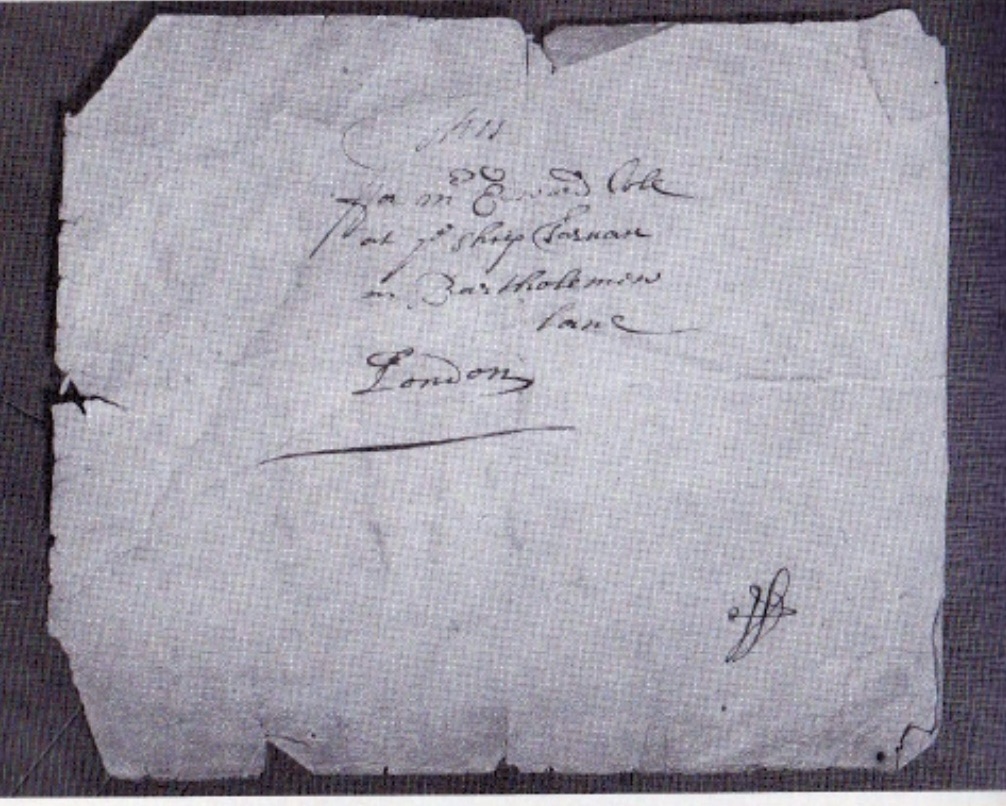
På väggen ska en bild ha suttit. Enligt noteringar var tavlan ”The fiskermans widow”, några tror att det var en tavla från marknaden men mest troligt är det att bilden var utriven ur en almanacka.
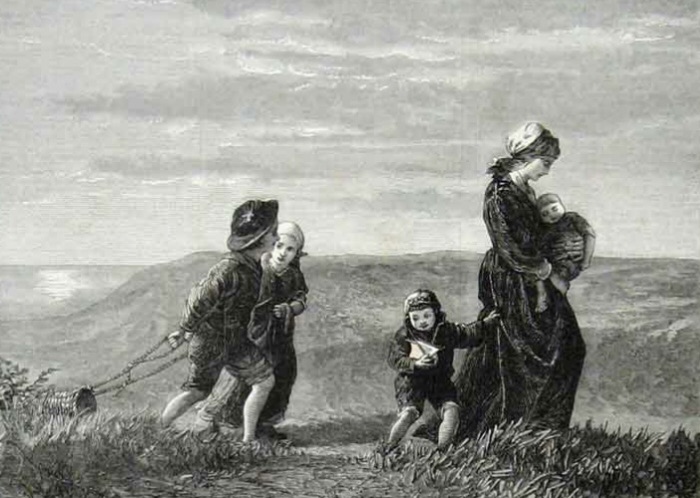
Obduktionen
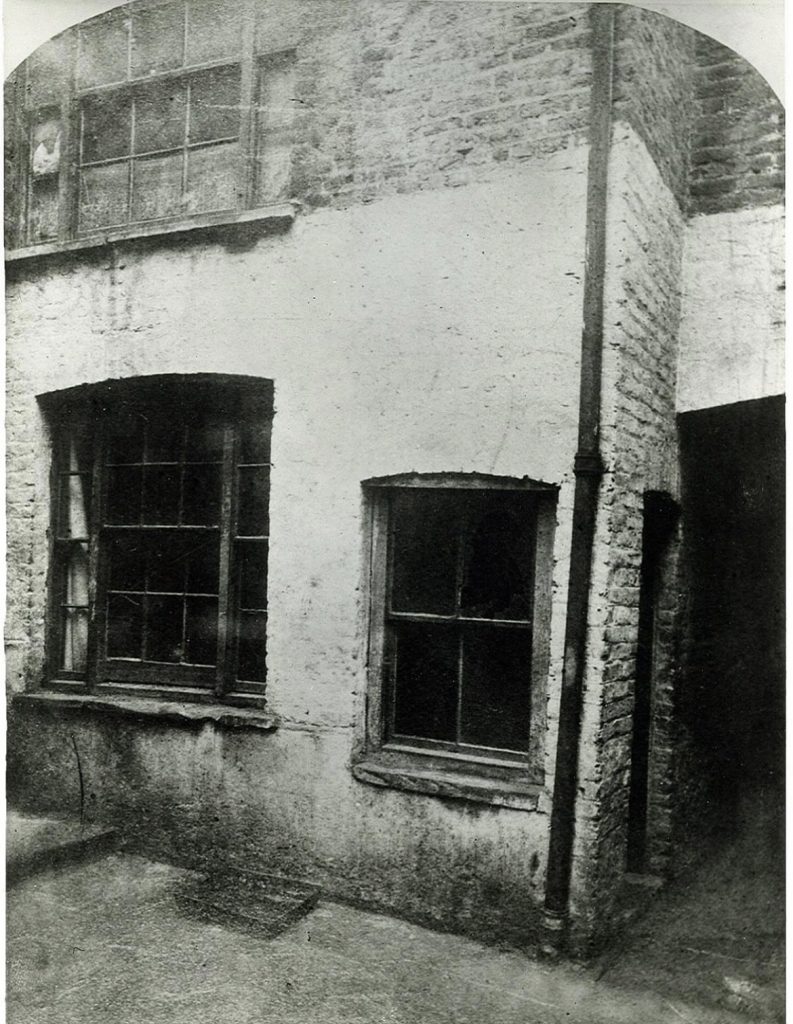
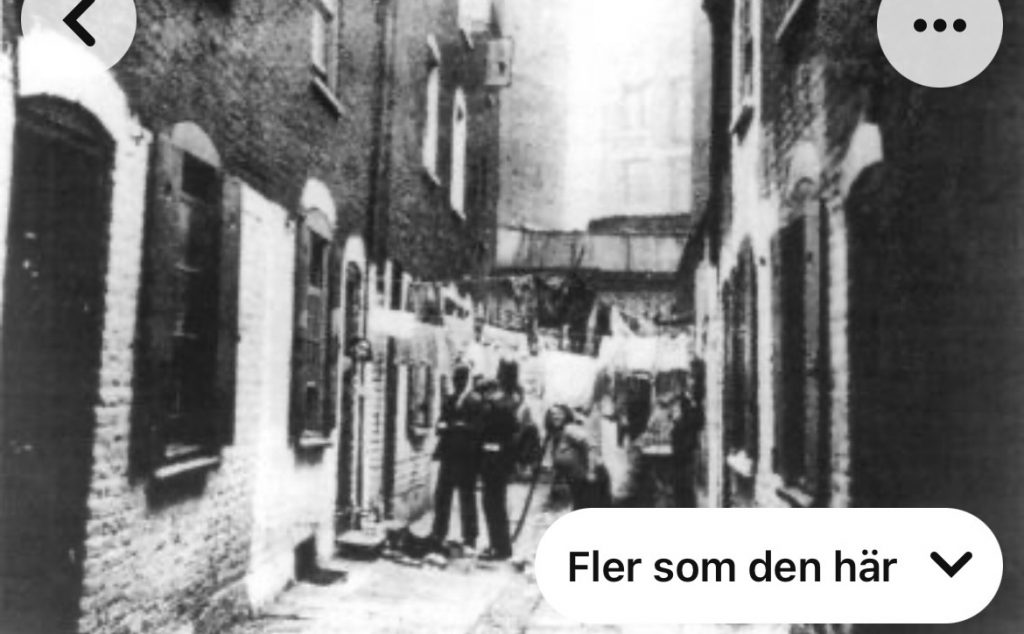
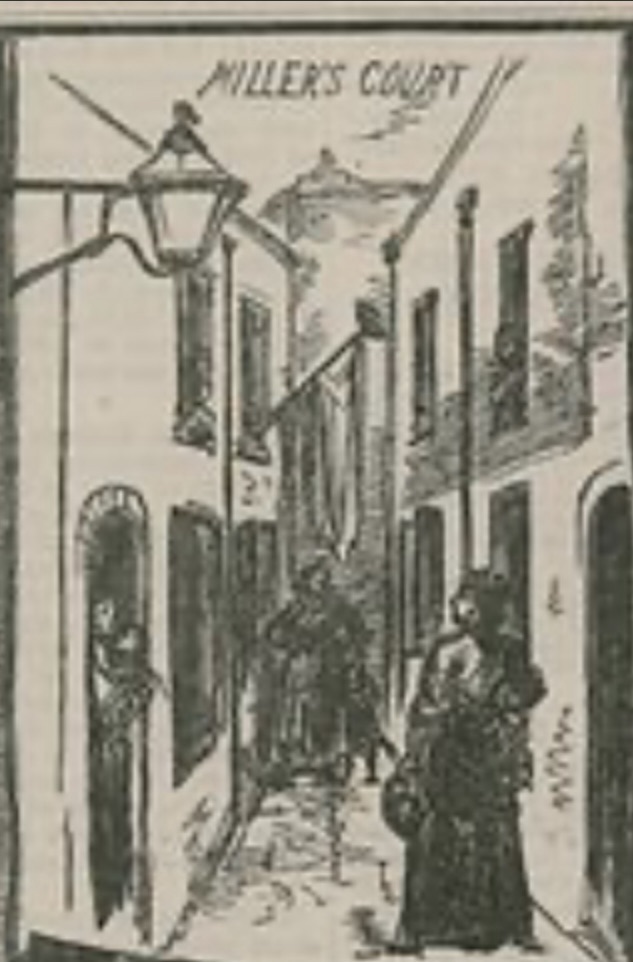
Dr. Thomas Bond, från polisens A-Division,var den som kallades till mordplatsen. Han rapporterar följande:
Kroppen låg på rygg, naken, i sängen. Huvudet var vrider åt vänster. Vänster armen låg nära kroppen och underarmen låg över magen.
Höger armen var nästan avskuren från kroppen och låg på madrassen bredvid kroppen. Benen var brett särade, vänster låret var mer mot madrassen medan höger pekade mer uppåt.
Hela bröstpartiet var bortskuret, lika så låren. båda brösten var bortskurna, armarna kraftigt knivhuggna och ansiktet totalt sönder hugget. Nacken var skuren ner till benet.
Livmodern, njurarna och ett bröst var placerade under huvudet. Det andra bröstet vid hennes högra fot. Levern var placerad mellan fötterna. Inälvorna var placerade på vänster sida om kroppen och mjälten på den högra sidan. Huden från bröstet och låren var placerade på bordet bredvid kroppen.
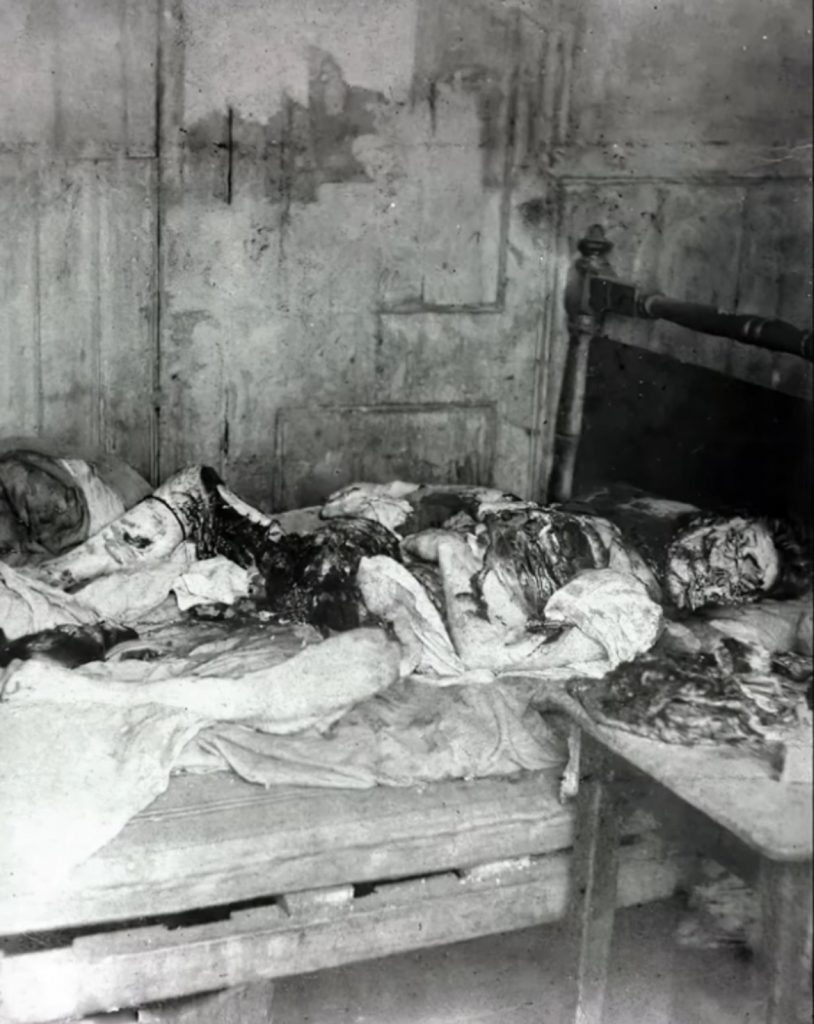
Det var mycket blod i sängen och på golvet under. Det var blodstänk på väggarna.
Hennes ansikte var sönderskuret och näsan, ögonen, ögonlock och öron, var delvis bortskurna. Läpparna och kinderna hade djupa sår ner till benet. Det var också skärsår åt alla möjliga håll.
Halsen var uppskuren. Det följer flertalet detaljerade observationer av hur djup och hur mycket som skurits bort. Under en av naglarna hittas skinn, vilket skulle kunna tyda på att Mary rev JTR, men kunde även varit från henne själv.
”The right thumb showed a small superficial incision about one inch long, with extravasation of blood in the skin, and there were several abrasions on the back of the hand moreover showing the same condition.”
Bröstkorgen var öppnad och hennes hjärta saknades.
Dr. George Bagster Phillips var också på plats och han säger:
”The mutilated remains of a female were lying two-thirds over towards the edge of the bedstead nearest the door. She had only her chemise on, or some underlinen garment. I am sure that the body had been removed subsequent to the injury which caused her death from that side of the bedstead that was nearest the wooden partition, because of the large quantity of blood under the bedstead and the saturated condition of the sheet and the palliasse at the corner nearest the partition.”
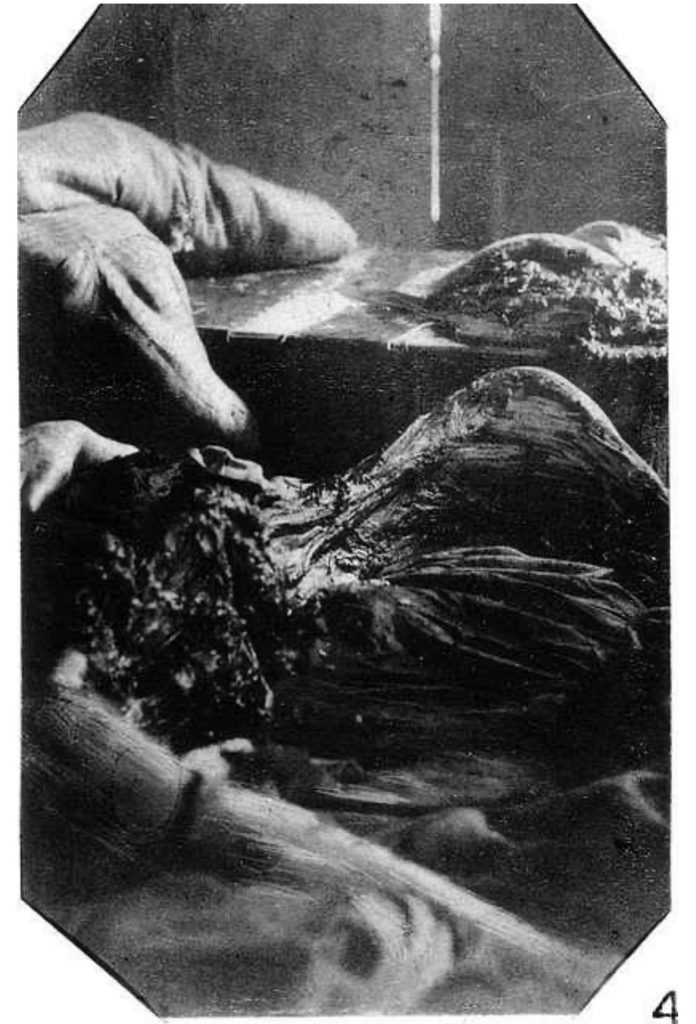

Dr. Bond’s Post Mortem on Mary Kelly
This post-mortem report was written by Dr. Thomas Bond after he examined the remains of Mary Jane Kelly. The report was lost until 1987, when it was returned anonymously to Scotland Yard.
——————————————————————————–
Position of body
The body was lying naked in the middle of the bed, the shoulders flat, but the axis of the body inclined to the left side of the bed. The head was turned on the left cheek. The left arm was close to the body with the forearm flexed at a right angle & lying across the abdomen. the right arm was slightly abducted from the body & rested on the mattress, the elbow bent & the forearm supine with the fingers clenched. The legs were wide apart, the left thigh at right angles to the trunk & the right forming an obtuse angle with the pubes.
The whole of the surface of the abdomen & thighs was removed & the abdominal Cavity emptied of its viscera. The breasts were cut off, the arms mutilated by several jagged wounds & the face hacked beyond recognition of the features. The tissues of the neck were severed all round down to the bone.
The viscera were found in various parts viz: the uterus & Kidneys with one breast under the head, the other breast by the Rt foot, the Liver between the feet, the intestines by the right side & the s pleen by the left side of the body. The flaps removed from the abdomen and thighs were on a table.
The bed clothing at the right corner was saturated with blood, & on the floor beneath was a pool of blood covering about 2 feet square. The wall by the right side of the bed & in a line with the neck was marked by blood which had struck it in a number of spearate splashes.
Postmortem examination
The face was gashed in all directions the nose cheeks, eyebrows and ears being partly removed. The lips were blanched & cut by several incisions running obliquely down to the chin. There were also numerous cuts extending irregularly across all the features.
The neck was cut through the skin & other tissues right down to the vertebrae the 5th & 6th being deeply notched. The skin cuts in the front of the neck showed distinct ecchymosis.
The air passage was cut at the lower part of the larynx through the cricoid cartilage.
Both breasts were removed by more or less circular incisions, the muscles down to the ribs being attached to the breasts. The intercostals between the 4th, 5th & 6th ribs were cut through & the contents of the thorax visible through the openings.
The skin & tissues of the abdomen from the costal arch to the pubes were removed in three large flaps. The right thigh was denuded in front to the bone, the flap of skin, including the external organs of generation & part of the right buttock. The left thigh was stripped of skin, fascia & muscles as far as the knee.
The left calf showed a long gash through skin & tissues to the deep muscles & reaching from the knee to 5 ins above the ankle.
Both arms & forearms had extensive & jagged wounds.
The right thumb showed a small superficial incision about 1 in long, with extravasation of blood in the skin & there were several abrasions on the back of the hand moreover showing the same condition.
On opening the thorax it was found that the right lung was minimally adherent by old firm adhesions. The lower part of the lung was broken & torn away.
The left lung was intact: it was adherent at the apex & there were a few adhesions over the side. In the substaces of the lung were several nodules of consolidation.
The Pericardium was open below & the Heart absent.
In the abdominal cavity was some partially digested food of fish & potatoes & similar food was found in the remains of the stomach attached to the intestines.
Mary Jane Kelly A.K.A.. Marie Jeanette Kelly, Mary Ann Kelly, Ginger
Mary Jane Kelly was approximately 25 years old at the time of her death which would place her birth around 1863. She was 5′ 7″ tall and stout. She had blonde hair, blue eyes and a fair complexion. ”Said to have been possessed of considerable personal attractions.” (McNaughten)
She was last seen wearing a linsey frock and a red shawl pulled around her shoulders. She was bare headed. Detective Constable Walter Dew claimed to know Kelly well by sight and says that she was attractive and paraded around, usually in the company of two or three friends. He says she always wore a spotlessly clean white apron.
Maria Harvey, a friend, says that she was ”much superior to that of most persons in her position in life.”
It is also said that she spoke fluent Welsh.
Joseph Barnett says that he ”always found her of sober habits.”
Landlord John McCarthy says ”When in liquor she was very noisy; otherwise she was a very quiet woman.”
Caroline Maxwell says that she ”was not a notorious character.”
Catherine Pickett claims ”She was a good, quiet, pleasant girl, and was well liked by all of us.”
History:
Almost everything that is known about Mary Jane Kelly comes from Joseph Barnett, who lived with her just prior to the murder. He, of course, had all this information from Kelly herself. Some is conflicting and it may be suspected that some, or perhaps much of it, is embellished.
She was born in Limerick, Ireland but we do not know if that refers to the county or the town. As a young child she moved with her family to Wales.
Her father was John Kelly who worked in an iron works in either Carnarvonshire or Carmarthenshire. Mary Jane claims to have 6 or 7 brothers and one sister. She says that one brother, Henry, whose nickname is Johnto is a member of the 2nd Battalion Scots Guards. As a member of this battalion he would have been stationed in Dublin, Ireland. She also claims to Lizzie Albrook that she had a relative on the London stage.
John McCarthy, landlord at Miller’s Court, states that she received a letter from her mother in Ireland. Barnett says that she never corresponded with her family.
John McCarthy was born in Dieppe and is married with four children. He owns a chandler’s shop at 27 Dorset Street on one side of the entrance to Miller’s Court. He is described as a gentlemanly looking fellow.
Joseph Barnett and Mrs. Carthy, a woman with whom she lived at one time, say that she came from a family that was ”fairly well off” (Barnett) and ”well to do people” (Carthy). Mrs. Carthy also states that Kelly was ”an excellent scholar and an artist of no mean degree.”
Mrs. Carthy is the landlady from Breezer’s Hill, Ratcliffe Highway. Barnett refers to her house as ”a bad house.”
c. 1879: At the age of 16 she marries a collier named Davies. He is killed in an explosion two or three years later. There is a suggestion that there might have been a child in this marriage.
Kelly moves to Cardiff and lives with a cousin and works as a prostitute. The Cardiff police have no record of her. She says she was ill and spent the best part of the time in an infirmary.
She arrives in London in 1884.
She may have stayed with the nuns at the Providence Row Convent on Chrisp Street. According to one tradition she scrubbed floors and charred here and was eventually placed into domestic service in a shop in Cleveland Street.
According to Joseph Barnett, on arriving in London, Kelly went to work in a high class brothel in the West End. She says that during this time she frequently rode in a carriage and accompanied one gentleman to Paris, which she didn’t like and she returned.
On November 10, one day after the murder, Mrs. Elizabeth Pheonix of 57 Bow Common Lane, Burdett Road, Bow, went to the Leman Street Police Station and said that a woman matching the description of Kelly used to live in her brother-in-law’s house in Breezer’s Hill, off Pennington Street.
Mrs. Pheonix says that ”She was Welsh and that her parents, who had discarded her, still lived in Cardiff, from which place she came. But on occasions she declared that she was Irish.” She added that Mary Jane was very abusive and quarrelsome when she was drunk but ”one of the most decent and nice girls you could meet when sober.”
A Press Association reporter who looked into the Breezer’s Hill District wrote:
”It would appear that on her arrival in London she made the acquaintance of a French woman residing in the neighborhood of Knightsbridge, who, she informed her friends, led her to pursue the degraded life which had now culminated in her untimely end. She made no secret of the fact that while she was with this woman she would drive about in a carriage and made several journeys to the French capital, and, in fact, led a life which is described as that ”of a lady.” By some means, however, at present, not exactly clear, she suddenly drifted into the East End. Here fortune failed her and a career that stands out in bold and sad contrast to her earlier experience was commenced. Her experiences with the East End appears to have begun with a woman (according to press reports a Mrs. Buki) who resided in one of the thoroughfares off Ratcliffe Highway, known as St. George’s Street. This person appears to have received Kelly direct from the West End home, for she had not been there very long when, it is stated, both women went to the French lady’s residence and demanded the box which contained numerous dresses of a costly description.
Kelly at last indulged in intoxicants, it is stated, to an extant which made her unwelcome. From St. George’s Street she went to lodge with a Mrs. Carthy at Breezer’s Hill (off Pennington Street). This place she left about 18 months or two years ago and from that time on appears to have left Ratcliffe all together.
Mrs. Carthy said that Kelly had left her house and gone to live with a man who was in the building trade and who Mrs. Carthy believed would have married Kelly.”
c. 1886: Kelly leaves Carthy’s house to live with a man in the building trades. Barnett says she lived with a man named Morganstone opposite or in the vicinity of Stepney Gasworks. She had then taken up with a man named Joseph Fleming and lived somewhere near Bethnal Green. Fleming was a stone mason or mason’s plasterer. He used to visit Kelly and seemed quite fond of her. A neighbor at Miller’s Court, Julia Van Turney says that Kelly was fond of a man other than Barnett and whose name was also Joe. She thought he was a costermonger and sometimes visited and gave money to Kelly.
By 1886 she is living in Colley’s lodging house in Thrawl Street, Spitalfields and it is here that she meets Joe Barnett.
Joseph Barnett is London born of Irish heritage. He is a riverside laborer and market porter who is licensed to work at Billingsgate Fish Market. He comes from a family of three sisters and one brother who is named Daniel. Barnett was born in 1858 and dies in 1926.
Julia Van Turney says that Joe Barnett is of good character and was kind to Mary Jane, giving her money on occasion.
Barnett and Kelly are remembered as a friendly and pleasant couple who give little trouble unless they are drunk. She may be the Mary Jane Kelly who was fined 2/6 by the Thames Magistrate Court on September 19, 1888 for being drunk and disorderly.
Good Friday, April 8, 1887: Joseph Barnett meets Mary Jane Kelly for the first time in Commercial Street. He takes her for a drink and arranges to meet her the following day. At their second meeting they arrange to live together.
They take lodging at in George Street, off Commercial. Later they move to Paternoster Court off Dorset Street. They are evicted for not paying rent and for being drunk. Next they move to Brick Lane.
In February or March of 1888 they move from Brick Lane to Miller’s Court off Dorset Street. Here they occupy a single room which is designated 13 Miller’s Court.
Miller’s Court:
Contemporary Sketch of Miller’s Court.
Opposite Crossingham’s lodging house oat 35 Dorset Street, where Annie Chapman lived, and between numbers 26 and 27 Dorset Street is a three foot wide opening that was the entrance to Miller’s Court. It is the first archway on the right of Dorset Street coming from Commercial Street. There were six houses in the court, each whitewashed up to the first floor windows. The rooms were let by John McCarthy, who owned a chandler’s shop at 27 Dorset Street.
Number 13 Miller’s Court was the back parlor of 26 Dorset Street. Partitioned off from the rest of the building, it was entered from a door at the end of the arched passageway. It was the first door on the right in Miller’s Court and anyone entering or leaving the court would have to pass it.
The room was approximately 12 feet square. Opposite the door was a fireplace. On the left of the door and at right angles to it were two windows, one of which was close enough to the door as to be able to reach through it and unbolt the door. To the right of the door was a bedside table so close that the door would hit it when opened. Next to the table was a bed with the head against the door wall, its side against the right wall. The room contained two tables and a chair and a cheap print entitled ”The Fisherman’s widow” hanging over the fireplace. Opposite the fireplace was a small cupboard which contained cheap crockery, empty ginger beer bottles and a little stale bread.
Contemporary photograph of the window at 13 Miller’s Court.
The key to the door was missing. The window closest it was broken and stuffed with rags and you could reach the spring lock of the door through the window. A man’s pilot coat hung over the window in place of a curtain. The window, according to Julia Van Turney, was broken several weeks before the murder by Kelly when she was drunk.
Also found in the room by the police was remnants of clothes in the grate of the fireplace. They had been burned in a fire so hot that it melted the spout off a nearby kettle. Mrs. Harvey believes the clothes are hers as she had left a hat, jacket, two men’s shirts, a boy’s shirt and a child’s petticoat in Kelly’s room. The pilot coat hanging over the window was also hers.
Kelly had taken the room under her own name and paid 4/6 per week rent. At the time of her death she was 30 shillings behind in rent.
August or early September, 1888: Barnett loses his job and Mary Jane returns to the streets. Barnett decides to leave her.
October 30, between 5 and 6 PM: Elizabeth Prater, who lives above Kelly reports that Barnett and Kelly have an argument and Barnett leaves her. He goes to live at Buller’s boarding house at 24-25 New Street, Bishopsgate.
Barnett states at the inquest that he left her because she was allowing other prostitutes to stay in the room. ”She would never have gone wrong again,” he tells a newspaper, ”and I shouldn’t have left her if it had not been for the prostitutes stopping at the house. She only let them (stay there) because she was good hearted and did not like to refuse them shelter on cold bitter nights.” He adds, ”We lived comfortably until Marie allowed a prostitute named Julia to sleep in the same room; I objected: and as Mrs. Harvey afterwards came and stayed there, I left and took lodgings elsewhere.”
Maria Harvey stayed with Kelly on the nights of November 5 and 6. She moved to new lodgings at 3 New Court, another alley of Dorset Street.
Wednesday, November 7: Mary Jane buys a half penny candle from McCarthy’s shop. She is later seen in Miller’s Court by Thomas Bowyer, a pensioned soldier whose nickname is ”Indian Harry.” He is employed by McCarthy and lives at 37 Dorset Street.
Bowyer states that on Wednesday night he saw a man speaking to Kelly who closely resembled the description of the man Matthew Packer claims to have seen with Elizabeth Stride. His appearance was smart and attention was drawn to him by his very white cuffs and rather long, white collar which came down over the front of his long black coat. He did not carry a bag.
Thursday-Friday, November 8-9: Almost every day after the split, Barnett would visit Mary Jane. On Friday the ninth he stops between 7:30 and 7:45 PM. He says she is in the company of another woman who lives in Miller’s Court. This may have been Lizzie Albrook who lived at 2 Miller’s Court.
Albrook says ”About the last thing she said to me was ’Whatever you do don’t you do wrong and turn out as I did.’ She had often spoken to me in this way and warned me against going on the street as she had done. She told me, too, that she was heartily sick of the life she was leading and wished she had money enough to go back to Ireland where her people lived. I do not believe she would have gone out as she did if she had not been obliged to do so to keep herself from starvation.”
Maria Harvey also says that she was woman that Barnett saw with Mary Jane and that she left at 6:55 PM.
8:00 PM: Barnett leaves and goes back to Buller’s boarding house where he played whist until 12:30 AM and then went to bed.
8:00 PM: Julia Van Turney, who lives at 1 Miller’s Court goes to bed.
There are no confirmed sightings of Mary Jane Kelly between 8:00 PM and 11:45 PM. there is an unconfirmed story that she is drinking with a woman named Elizabeth Foster at the Britannia Public House.
11:00 PM: It is said she is in the Britannia drinking with a young man with a dark mustache who appears respectable and well dressed. It is said she is very drunk.
11:45 PM: Mary Ann Cox, a 31 year old widower and prostitute, who lives at 5 Miller’s Court (last house on the left) enters Dorset Street from Commercial Street. Cox is returning home to warm herself as the night had turned cold. She sees Kelly ahead of her, walking with a stout man. The man was aged around 35 or 36 and was about 5′ 5″ tall. He was shabbily dressed in a long overcoat and a billycock hat. He had a blotchy face and small side whiskers and a carrotty mustache. The man is carrying a pail of beer.
Mrs. Cox follows them into Miller’s Court. they are standing outside Kelly’s room as Mrs. Cox passed and said ”Goodnight.” Somewhat incoherently, Kelly replied ”Goodnight, I am going to sing.” A few minutes later Mrs. Cox hears Kelly singing ”A Violet from Mother’s Grave” (see below). Cox goes out again at midnight and hears Kelly singing the same song.
You may listen to ”A Violet from Mother’s Grave” in RealAudio format [398 Kb] (voice and instrumental), or you may view the sheet music and listen to a much smaller midi version (instrumental only). RealAudio version courtesy Frogg Moody and the production staff of Yours Truly, Jack the Ripper.
Somewhere in this time period, Mary Jane takes a meal of fish and potatoes.
12:30 AM: Catherine Picket, a flower seller who lives near Kelly, is disturbed by Kelly’s singing. Picket’s husband stops her from going down stairs to complain. ”You leave the poor woman alone.” he says.
1:00 AM: It is beginning to rain. Again, Mary Ann Cox returns home to warm herself. At that time Kelly is still singing or has begun to sing again. There was light coming from Kelly’s room. Shortly after one, Cox goes out again.
Elizabeth Prater, the wife of William Prater, a boot finisher who had left her 5 years before, is standing at the entrance to Miller’s Court waiting for a man. Prater lives in room number 20 of 26 Dorset Street. This is directly above Kelly. She stands there about a half hour and then goes into to McCarthy’s to chat. She hears no singing and sees no one go in or out of the court. After a few minutes she goes back to her room, places two chairs in front of her door and goes to sleep without undressing. She is very drunk.
2:00 AM: George Hutchinson, a resident of the Victoria Home on Commercial Street has just returned to the area from Romford. He is walking on Commercial Street and passes a man at the corner of Thrawl Street but pays no attention to him. At Flower and Dean Street he meets Kelly who asks him for money. ”Mr. Hutchinson, can you lend me sixpence?” ”I can’t,” say Hutchinson, ”I spent all my money going down to Romford.” ”Good morning,” Kelly replies, ”I must go and find some money.” She then walks in the direction of Thrawl Street.
She meets the man Hutchinson had passed earlier. The man puts his hand on Kelly’s should and says something at which Kelly and the man laugh. Hutchinson hears Kelly say ”All right.” and the man say ”You will be all right for what I have told you.” The man then puts his right hand on Kelly’s shoulder and they begin to walk towards Dorset Street. Hutchinson notices that the man has a small parcel in his left hand.
While standing under a street light on outside the Queens Head Public House Hutchinson gets a good look at the man with Mary Jane Kelly. He has a dark complexion, a heavy dark mustache, turned up at the corners, dark eyes and bushy eyebrows. He is, according to Hutchinson, ”Jewish looking.” The man is wearing a soft felt hat pulled down over his eyes, a long dark coat trimmed in astrakhan, a white collar with a black necktie fixed with a horseshoe pin. He wears dark spats over light button over boots. A massive gold chain is in his waistcoat with a large seal with a red stone hanging from it. He carries kid gloves in his right hand and a small package in his left. He is 5′ 6″ or 5′ 7″ tall and about 35 or 36 years old.
Kelly and the man cross Commercial Street and turn down Dorset. Hutchinson follows them. Kelly and the man stop outside Miller’s Court and talk for about 3 minutes. Kelly is heard to say ”All right, my dear. Come along. You will be comfortable.” The man puts his arm around Kelly who kisses him. ”I’ve lost my handkerchief.” she says. At this he hands her a red handkerchief. The couple then heads down Miller’s Court. Hutchinson waits until the clock strikes 3:00 AM. leaving as the clock strikes the hour.
3:00 AM: Mrs. Cox returns home yet again. It is raining hard. There is no sound or light coming from Kelly’s room. Cox does not go back out but does not go to sleep. Throughout the night she occasionally hears men going in and out of the court. She told the inquest ”I heard someone go out at a quarter to six. I do not know what house he went out of (as) I heard no door shut.”
4:00 AM: Elizabeth Prater is awakened by her pet kitten ”Diddles” walking on her neck. She hears a faint cry of ”Oh, murder!” but, as the cry of murder is common in the district, she pays no attention to it. Sarah Lewis, who is staying with friends in Miller’s Court, also hears the cry.
8:30 AM: Caroline Maxwell, a witness at the inquest and acquaintance of Kelly’s, claims to have seen the deceased at around 8:30 AM, several hours after the time given by Phillips as time of death. She described her clothing and appearance in depth, and adamantly stated that she was not mistaken about the date, although she admitted she did not know Kelly very well.
10:00 AM: Maurice Lewis, a tailor who resided in Dorset Street, told newspapers he had seen Kelly and Barnett in the Horn of Plenty public house on the night of the murder, but more importantly, that he saw her about 10:00 AM the next day. Like Maxwell, this time is several hours from the time of death, and because of this discrepancy, he was not called to the inquest and virtually ignored by police.
Bowyer and McCarthy discover the body of Mary Jane Kelly.
10:45 AM: John McCarthy, owner of ”McCarthy’s Rents,” as Miller’s Court was known, sends Thomas Bowyer to collect past due rent money from Mary Kelly. After Bowyer receives no response from knocking (and because the door was locked) he pushes aside the curtain and peers inside, seeing the body. He informs McCarthy, who, after seeing the mutilated remains of Kelly for himself, ran to Commercial Road Police Station, where he spoke with Inspector Walter Beck, who returned to the Court with McCarthy.
Several hours later, after waiting fruitlessly for the arrival of the bloodhounds ”Barnaby” and ”Burgho,” McCarthy smashes in the door with an axe handle under orders from Superintendent Arnold.
When police enter the room they find Mary Jane Kelly’s clothes neatly folded on a chair and she is wearing a chemise. Her boots are in front of the fireplace.
Post-mortem
Dr. Thomas Bond, a distinguished police surgeon from A Division was called in on the Mary Kelly murder. His report is as follows:
Mary Kelly as she was found in her bed at 13 Miller’s Court.
”The body was lying naked in the middle of the bed, the shoulders flat but the axis of the body inclined to the left side of the bed. The head was turned on the left cheek. The left arm was close to the body with the forearm flexed at a right angle and lying across the abdomen.
The right arm was slightly abducted from the body and rested on the mattress. The elbow was bent, the forearm supine with the fingers clenched. The legs were wide apart, the left thigh at right angles to the trunk and the right forming an obtuse angle with the pubes.
The whole of the surface of the abdomen and thighs was removed and the abdominal cavity emptied of its viscera. The breasts were cut off, the arms mutilated by several jagged wounds and the face hacked beyond recognition of the features. The tissues of the neck were severed all round down to the bone.
The viscera were found in various parts viz: the uterus and kidneys with one breast under the head, the other breast by the right foot, the liver between the feet, the intestines by the right side and the spleen by the left side of the body. The flaps removed from the abdomen and thighs were on a table.
The bed clothing at the right corner was saturated with blood, and on the floor beneath was a pool of blood covering about two feet square. The wall by the right side of the bed and in a line with the neck was marked by blood which had struck it in a number of separate splashes.
The face was gashed in all directions, the nose, cheeks, eyebrows, and ears being partly removed. The lips were blanched and cut by several incisions running obliquely down to the chin. There were also numerous cuts extending irregularly across all the features.
The neck was cut through the skin and other tissues right down to the vertebrae, the fifth and sixth being deeply notched. The skin cuts in the front of the neck showed distinct ecchymosis. The air passage was cut at the lower part of the larynx through the cricoid cartilage.
Both breasts were more or less removed by circular incisions, the muscle down to the ribs being attached to the breasts. The intercostals between the fourth, fifth, and sixth ribs were cut through and the contents of the thorax visible through the openings.
Mary Kelly as she was found in her bed at 13 Miller’s Court.
The skin and tissues of the abdomen from the costal arch to the pubes were removed in three large flaps. The right thigh was denuded in front to the bone, the flap of skin, including the external organs of generation, and part of the right buttock. The left thigh was stripped of skin fascia, and muscles as far as the knee.
The left calf showed a long gash through skin and tissues to the deep muscles and reaching from the knee to five inches above the ankle. Both arms and forearms had extensive jagged wounds.
The right thumb showed a small superficial incision about one inch long, with extravasation of blood in the skin, and there were several abrasions on the back of the hand moreover showing the same condition.
On opening the thorax it was found that the right lung was minimally adherent by old firm adhesions. The lower part of the lung was broken and torn away. The left lung was intact. It was adherent at the apex and there were a few adhesions over the side. In the substances of the lung there were several nodules of consolidation.
The pericardium was open below and the heart absent. In the abdominal cavity there was some partly digested food of fish and potatoes, and similar food was found in the remains of the stomach attached to the intestines.”
Dr. George Bagster Phillips was also present at the scene, and gave the following testimony at the inquest:
”The mutilated remains of a female were lying two-thirds over towards the edge of the bedstead nearest the door. She had only her chemise on, or some underlinen garment. I am sure that the body had been removed subsequent to the injury which caused her death from that side of the bedstead that was nearest the wooden partition, because of the large quantity of blood under the bedstead and the saturated condition of the sheet and the palliasse at the corner nearest the partition.
The blood was produced by the severance of the cartoid artery, which was the cause of death. The injury was inflicted while the deceased was lying at the right side of the bedstead.”